- Event calendar
- Annapolis Sailboat Show
- Fort Lauderdale International Boat Show
- Miami International Boat Show
- Oceanis 30.1
- Oceanis 34.1
- Oceanis 37.1
- Oceanis 40.1
- Oceanis 46.1
- Oceanis 51.1
- Oceanis Yacht 54
- Oceanis Yacht 60
- FIGARO BENETEAU 3
- Heritage Sailing Yacht
- Flyer 7 SUNdeck
- Flyer 7 SPACEdeck
- Flyer 8 SUNdeck
- Flyer 8 SPACEdeck
- Flyer 9 SUNdeck
- Flyer 9 SPACEdeck
- Antares 7 Fishing
- Antares 8 Fishing
- ANTARES 11 FLY
- Gran Turismo 32
- Gran Turismo 36
- Gran Turismo 41
- Gran Turismo 45
- Swift Trawler 35
- Swift trawler 41 Sedan
- Swift trawler 41 Fly
- Swift Trawler 48
- Swift Trawler 54
- Grand Trawler 62
- Heritage Powerboats
- Future Owners
- A REMARKABLE ANNIVERSARY
- Our History
- Our Architects and Designers
- Our philosophy
- Our Innovations
- Your way to ownership
- Tests and Awards


Figaro BENETEAU 3
- Description
- Key Features
Specifications
The Figaro BENETEAU 3 is the first production foiling one-design monohull ever created. It is a distillation of technology and innovation, the result of a collaboration between some of BENETEAU’s best experts and the Van Peteghem Lauriot-Prévost (VPLP) office, the architects of the last two boats to win the Vendée Globe.
The prototype has been tested and the production of the boat has been launched. It will enter the ISO/World Sailing design category A.
Naval designer : Van Peteghem – Lauriot Prévost

YouTube est désactivé. Autorisez le dépôt de cookies liés aux vidéos pour accéder au contenu.
THE ADVENT OF A NEW STANDARD
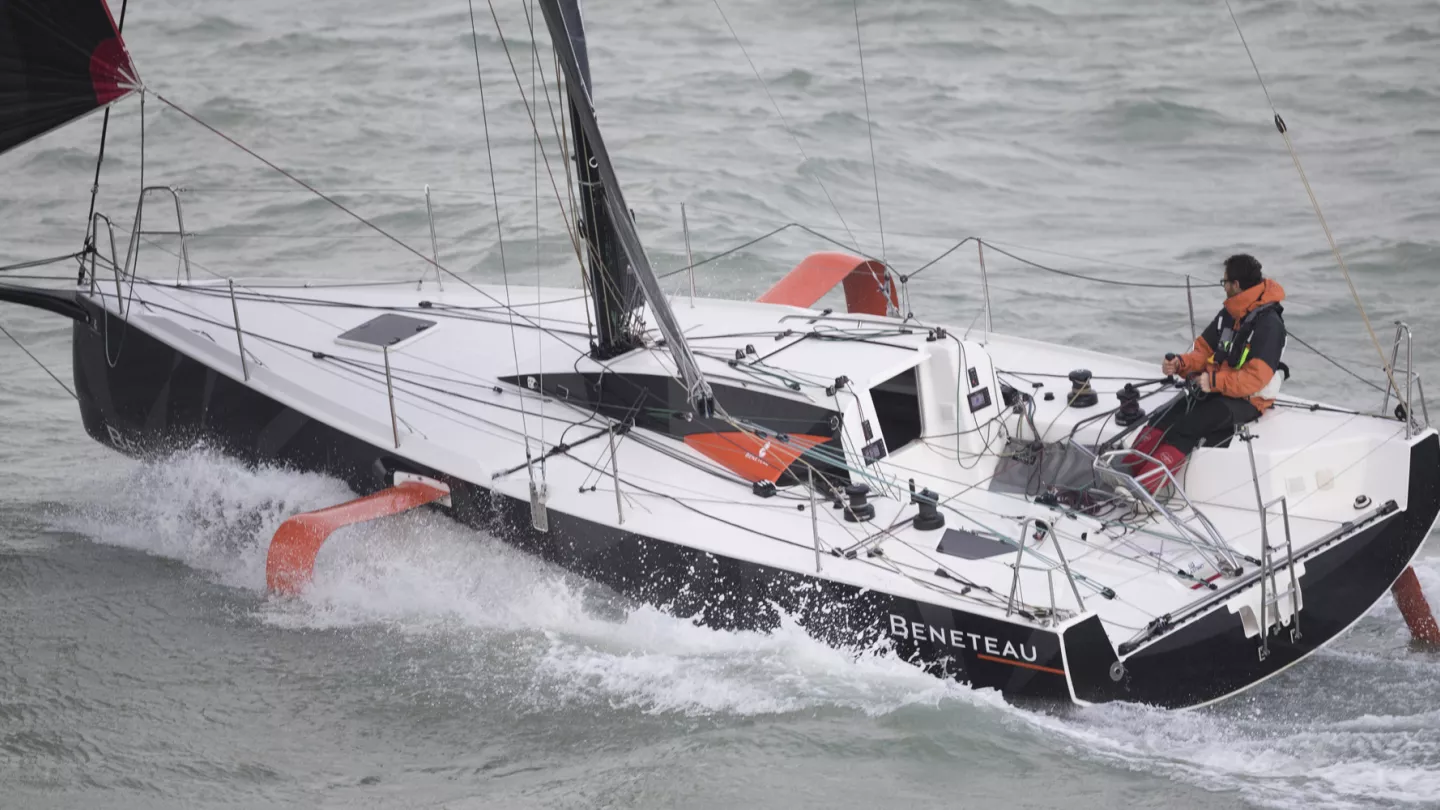
MODERNITY, RELIABILITY AND PERFORMANCE
The specifications define the FB3 monohull as being as reliable as its predecessor, the FB2. It is equipped with foils, a better-performing, ballast-free hull, a more slender and deeper keel, a setback mast and a more extensive, larger sail plan.
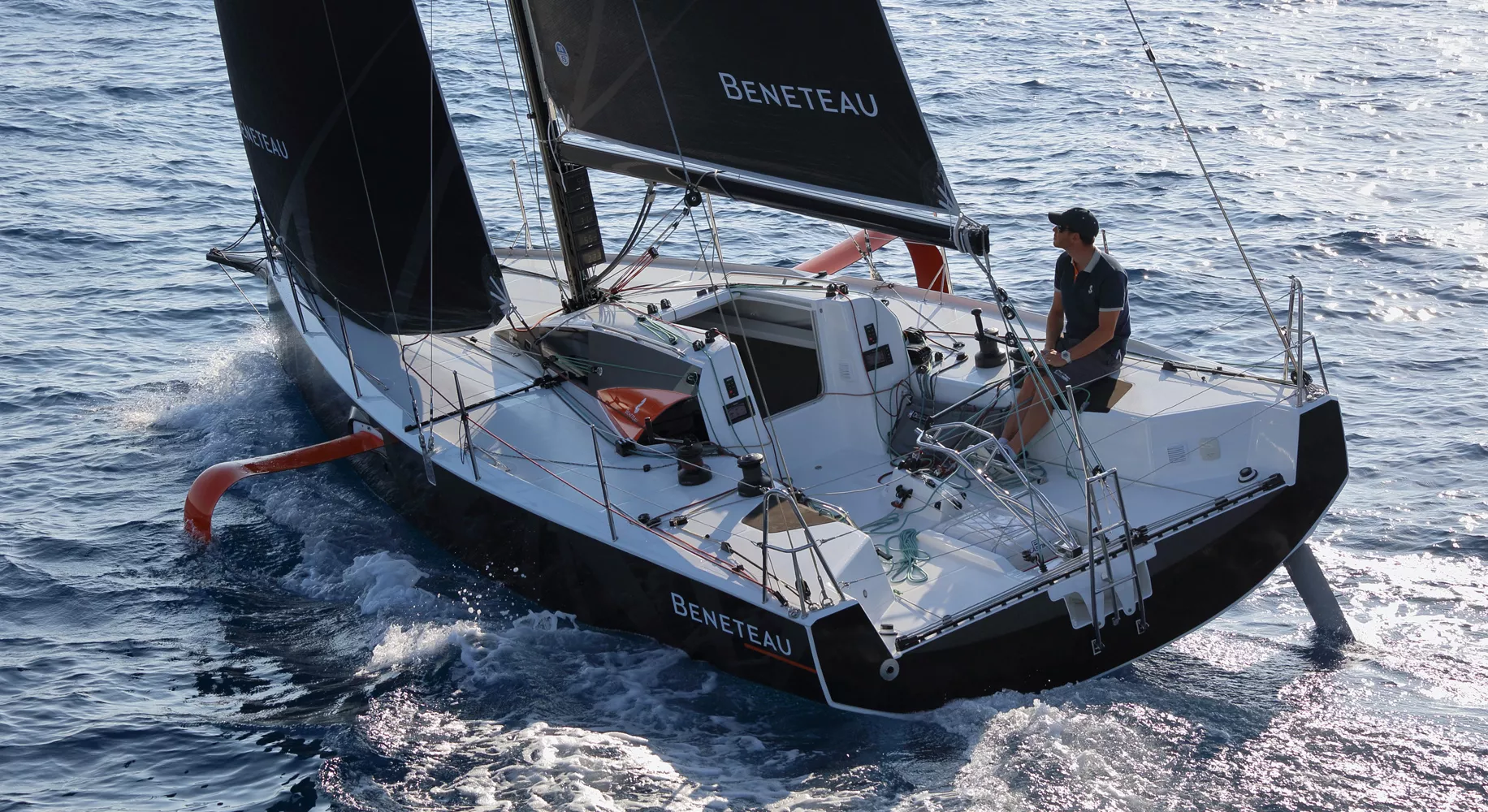
Contrary to Imoca 60 foils, the Figaro BENETEAU 3 foils have an inward-facing profile. The way they operate is different. They are versatile foils that create drift reduction and improve the boat’s righting moment, without increasing the movement, which improves the boat’s performance.
Deep, with a straight blade, it creates minimum drag. Supplementary drift reduction is provided by the foils.
Made of foam sandwich, fibreglass and polyester-infused resin, it corresponds with current designs and is ballast-free.
MAST AND SAIL LAYOUT
Similar to the Imoca 60s, the mast is set back, providing balance under sail. This allows the use of high performance sails and the addition of a bowsprit. Solo sailors will sail with a square-top mainsail, a genoa, and a jib, but also a masthead spinnaker (105 m² (=125 yd²) to gain speed in a light breeze) and a small gennaker.
- Mainsail area: 39.5 m² (420 ft²)
- Jib area: 30.5 m² (323 ft²)
- Large spinnaker area: 105 m² (125 yd²)
Equipped With SEANAPPS
The easiest way to keep your boat safe and ready to cruise anytime.
The new Seanapps app is the ultimate solution to help you indulge your passion for boating. With the touch of your finger, you can easily connect, monitor and order services for your boat – from routine maintenance, to requesting a wash or fuel or having us complete a repair.

The information below is intended for general informational purposes only and is subject to change without notice and does not constitute a contractual agreement. Any descriptions, representations, or statements made in this document are not to be considered binding unless explicitly stated otherwise in a formal contractual agreement.
Length Overall
Beam overall
Light displacement
Air Draft Max
Fuel Capacity
Max. engine power
CE Certification
A3 / B4 / C6
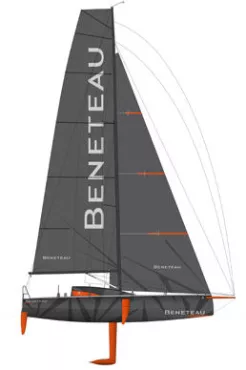
All Figaro news
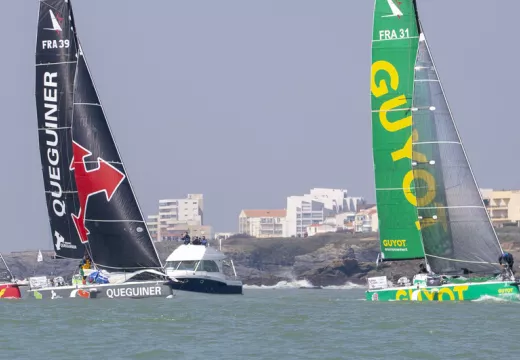
First Sardinha Cup
Victory for Yann Eliès and Samantha Davies
Customer Care
Buying a BENETEAU doesn’t have to be a daunting task. We have teams of experts to guide you through the entire process – everything from sea trials, financing, and customization to after-sale commissioning, service, and maintenance. We are proud to have one of the largest, most highly-regarded dealer networks in the world. We’re ready to provide you with the assistance and expertise needed to launch you and your BENETEAU on a lifetime of happy, rewarding, and memorable voyages.
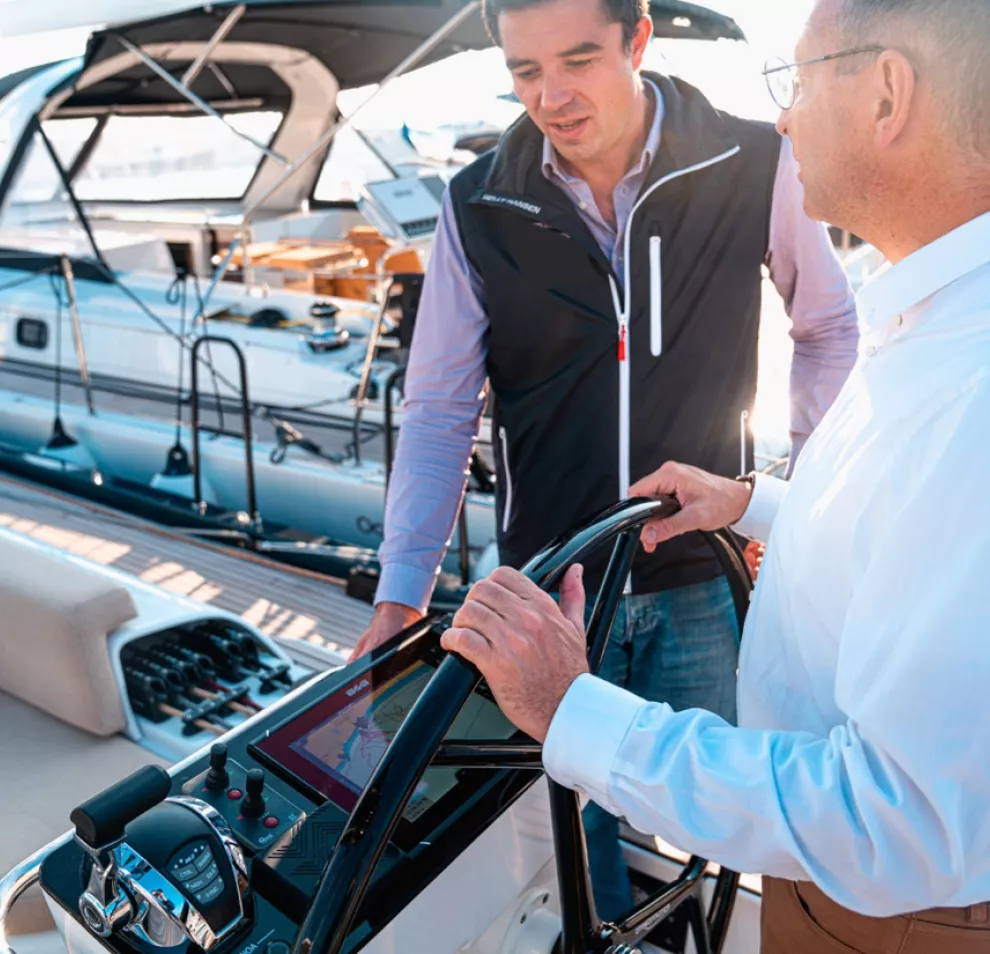
Select your area and your language
- Chinese, Simplified
The Lyncean Group of San Diego
The amazing america’s cup ac75 foiling monohull flying boat.
Peter Lobner, 25 February 2021
The first race of the 36 th America’s Cup racing series starts on 5 March 2021 in Auckland, New Zealand. The defending Emirates Team New Zealand and the challenging Luna Rossa Prada Pirelli Team will be sailing (or rather flying) a radical new class of America’s Cup boats knows as the AC75, which is a foiling monohull that was designed from the ground up to “fly” on its foils. It isn’t clear if the AC75 is a flying boat or a sailing airplane.
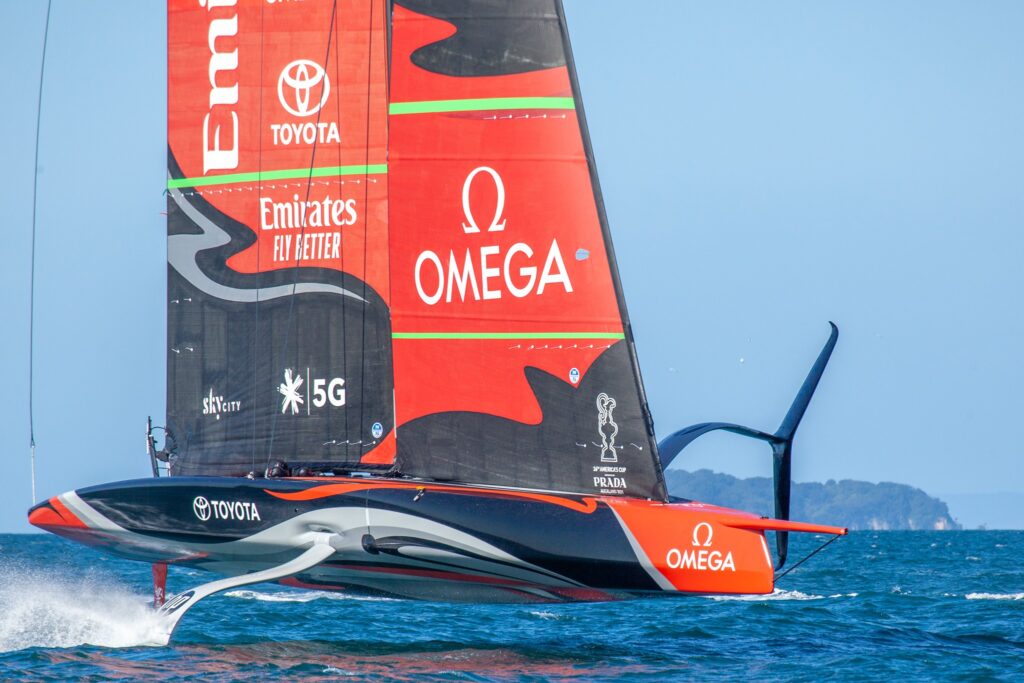
The Luna Rossa Prada Pirelli Team won the right to challenge based on its performance in the Prada Cup match races held from 14 January thru 20 February 2021. The America’s Cup races are scheduled from 5 to 14 March 2021. You’ll find complete information on the races on the America’s Cup website at the following link: https://www.americascup.com
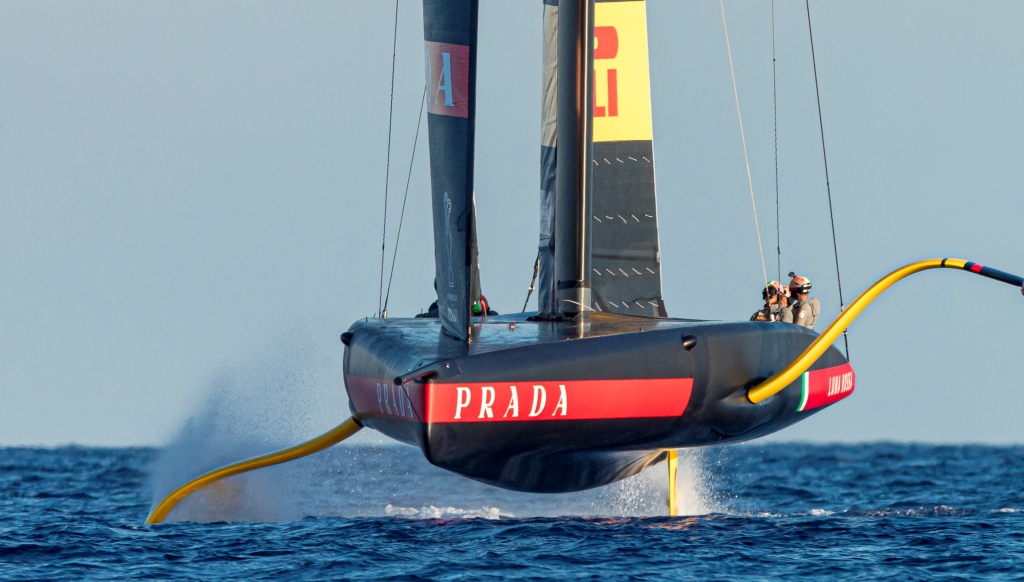
The New York Yacht Club American Magic entry, Patriot , was eliminated during the Prada Cup races, after recording no wins in the Round Robin series and no wins in the semi-final races against Luna Rossa . Patriot was damaged and in danger of sinking following a dramatic high-speed capsize following a tack in gusty wind conditions while leading Luna Rossa during Round Robin 2 Race 3 on 16 January 2021.
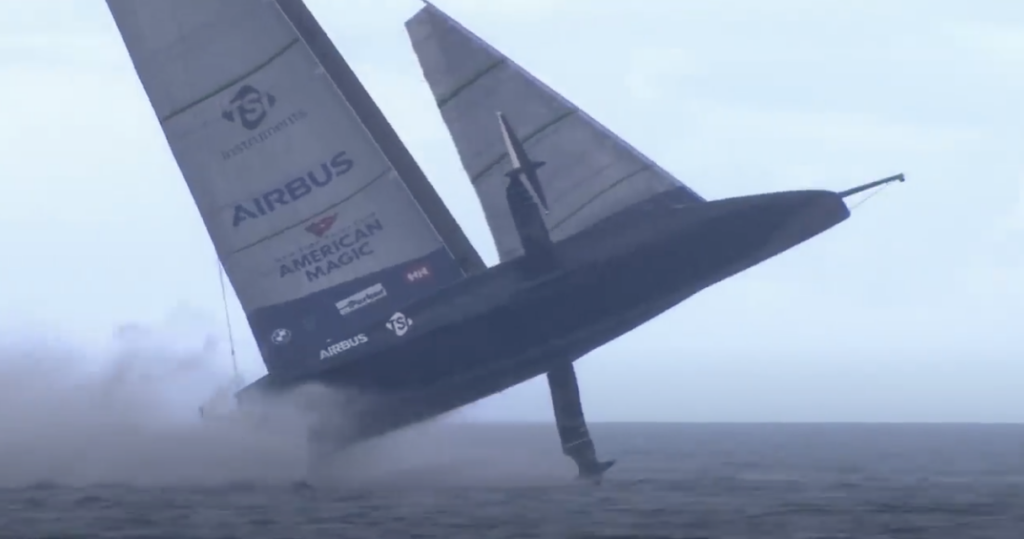
The AC75 operates with two completely different sets of boat dynamics:
- Waterborne while accelerating at maximum power to quickly reach foiling speed at 12 – 14 knots
- Flying on the foils to reach a top speed that can exceed 50 knots
Making a smooth transition from waterborne to flying on the foils can be a big challenge for the crew. As the transition is being made, the power demand drops rapidly (suddenly) as the hull emerges from the water and starts flying on the foils. The crew must quickly adjust sail power and trim to maintain control of the flying boat.
As you would expect, there are extensive regulations governing most aspects of the boat’s design. The Rule is explained at the following link: https://www.americascup.com/en/official/the-class-rule
To get an introduction to an AC75 boat and its primary components, you can view a 3-D model here: https://www.americascup.com/en/ac75
The AC75 is a very lightweight vessel, with a fully-loaded weight of 7,600 kg (16,800 lb). The empty weight, not including sails or crew, is limited to 6,520 kg (14,374 lbs.). Of that, 3,358.5 kg (7,403 lb) is supplied by, or specified by, the America’s Cup event organizer, and includes the following standard items for all teams.
- Mast : A detailed specification; essentially a one-design mast with a D-shaped leading edge; teams can choose their manufacturer.
- Rigging : Supplied to all teams.
- Media equipment: Cameras, mounting hardware, power & controls supplied to all teams.
- Foil cant arms and hydraulic control system : Standard system developed, tested and supplied to all teams by one manufacturer. The hydraulic system is powered manually by hand-operated grinders. The hydraulic system includes an interface to the trailing edge flaps on the foils supplied by each team.
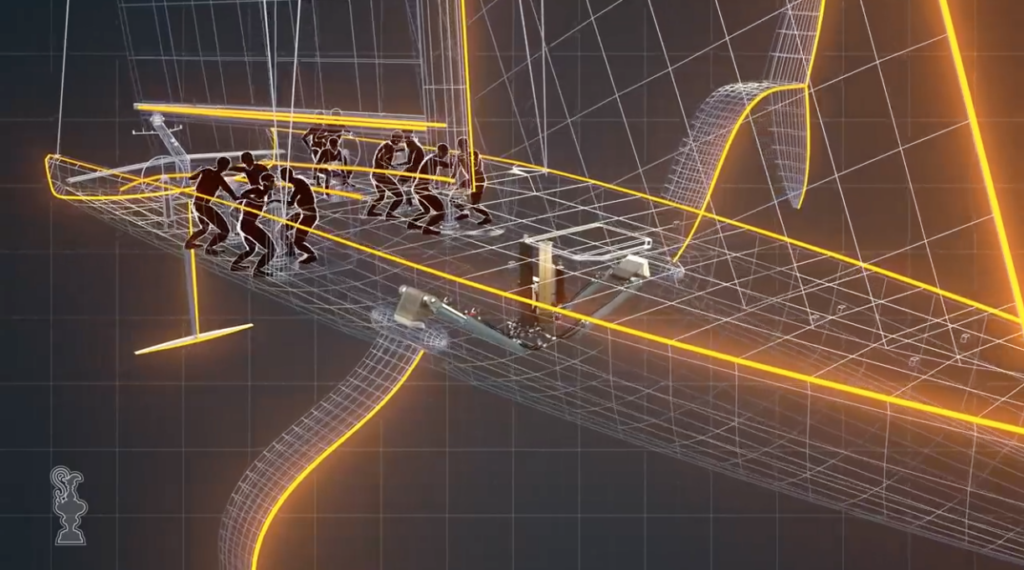
Each team is responsible for designing and building the rest of the boat while remaining within an empty weight budget of 3,161.5 kg (6,968 lb). The primary areas for innovation by each team are the following:
- Hull design: (maximum length 75 feet / 22.86 m), with the primary choice being a flat bottom or with skeg to provide a less sensitive transition between waterborne and foil borne modes.
- Crew and hand-operated grinder placement
- Twin-skin soft main sail: Forms a fabric 3-D airfoil
- Single-skin soft head sails
- Rudder + stern foil
- Foil wings, fairing and active trailing edge flaps: These are mounted to the standard cant arms; foils must be symmetrical with a maximum span 4 meters; flaps control lift; total weight is limited to about 1/3 rd the weight of the empty boat.
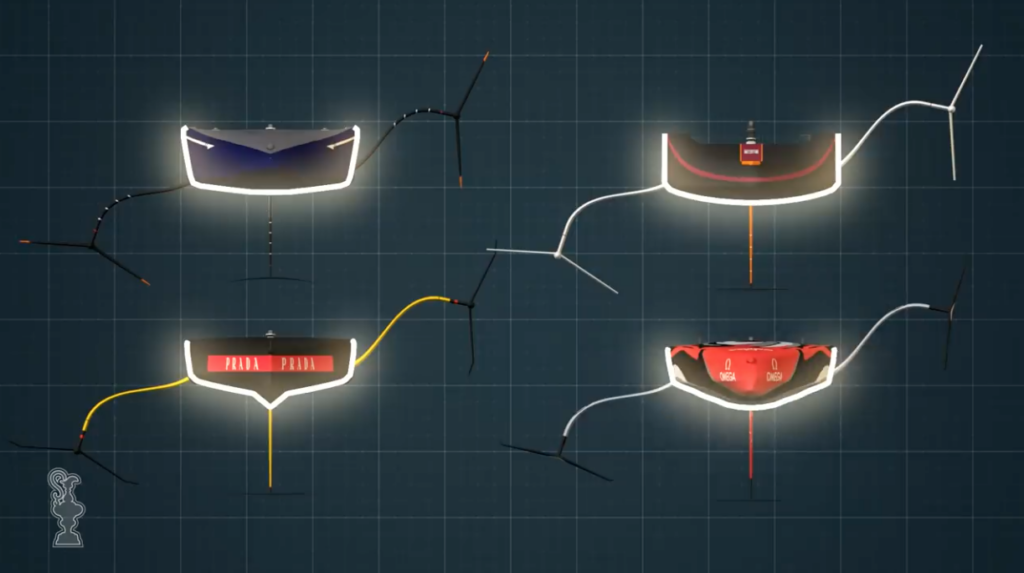
There are many AC75 videos available online, including many covering the exciting Prada America’s Cup World Series races in December 2020 and the Prada Cup races in January – February 2021. These boats are so fast that the races are short and action packed. I’ve listed several videos focusing more in boat technology below.
I hope you’ll enjoy a few of the AC75 videos and follow the America’s Cup Races. It’s not like any yacht racing you’ve seen before.
For more information:
- “The AC75 – The Technology,” Americas Cup: https://www.americascup.com/the-technology
- Mark Chisnell, “Weighing in on the AC75,” Sailing World, 15 September 2020: https://www.sailingworld.com/story/racing/weighing-in-on-the-ac75/
- Christopher McFadden, “The Engineering and Design Behind Modern Racing Yachts,” Interesting Engineering, 23 February 2021: https://interestingengineering.com/the-engineering-and-design-behind-modern-racing-yachts
- “The AC75 | Designed to Fly” (7:25 minutes), America’s Cup, 2 August 2020: https://www.youtube.com/watch?v=VQUl_hf6yo8&feature=emb_logo
- “America’s Cup – How Crews Handle Their AC75s” (17:41 minutes), Americas Cup, 24 January 2021: https://www.youtube.com/watch?v=o0bReWK_vsg
- “Sea Wolves – The new America’s cup boat! AC75 Technology analysis/Deep dive special! Auckland 2021” (51:07 minutes), Sea wolves, (with an introductory review of Americas Cup history by Troy Sears, owner of the replica yacht America , which is home ported in San Diego, CA), 16 December 2020: https://www.youtube.com/watch?v=sjs76uHEqeM
- “The American Magic Capsize – A Step by Step Explanation” (8:32 minutes), America’s Cup, 24 January 2021: https://www.youtube.com/watch?v=pXLUIouASdM
- BOAT OF THE YEAR
- Newsletters
- Sailboat Reviews
- Boating Safety
- Sails and Rigging
- Maintenance
- Sailing Totem
- Sailor & Galley
- Living Aboard
- Destinations
- Gear & Electronics
- Charter Resources
- Ultimate Boating Giveaway

Hydrofoils for Sailboats
- By By Steven Callahan
- Updated: July 29, 2020
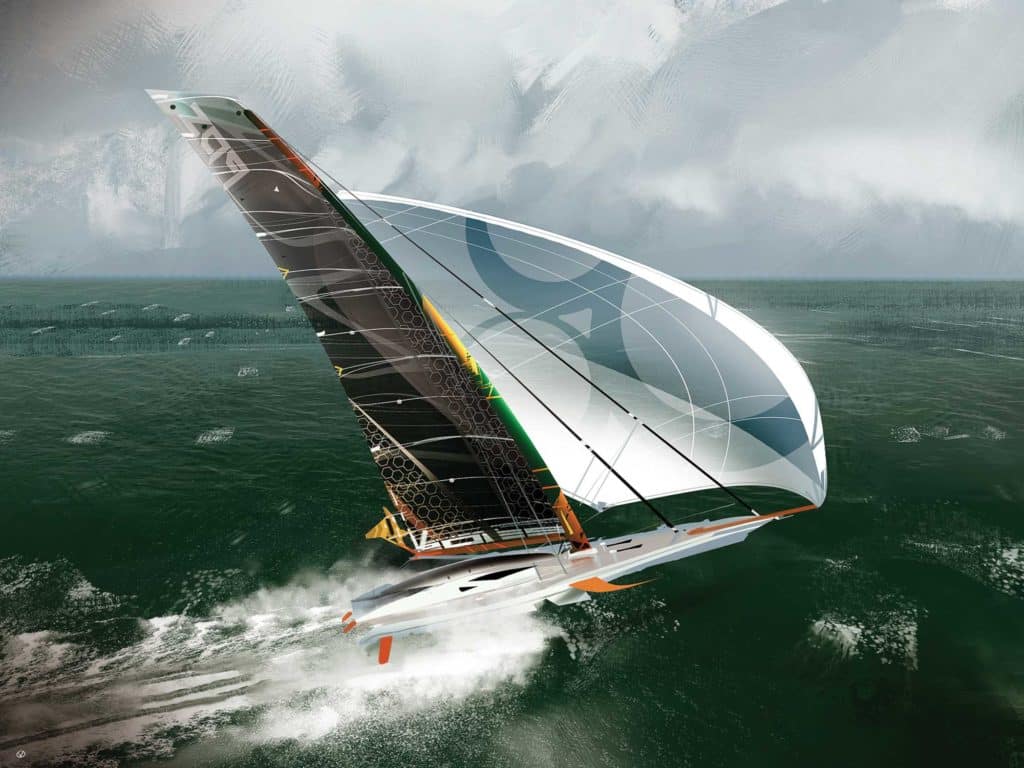
Hydrofoils have been providing dynamic lift since fish sprouted fins. And people have been employing foils ever since they first put paddle to water, and certainly since adding keels and rudders to boats. But the modern, flying America’s Cup boats, kiteboards, Moth dinghies, shorthanded offshore thoroughbreds—these are all playing in a new world in which the terms “hydrofoils” or “lifting foils” describe those oriented to raise a hull or hulls from the water. In these racing realms, if you ain’t got foils, you ain’t got nothin’.
Lifting foils that allow these boats to sometimes home in on three times the wind speed might appear to be of little interest to cruising sailors, but with such common cruising features as self-steering and autopilots, self-tailing winches, rope clutches, fin keels and faster hull shapes all having been passed down from the racing scene, one must ask, “What promise, if any, do hydrofoils hold?”
Lifted or partially lifted boat patents extend back to 1869, but workable watercraft took roots along with early flight. Italian Enrico Forlanini began experimenting with foils in 1898. In 1906, his 1-ton 60 hp foiler reached 42.5 mph. Alexander Graham Bell’s HD-4 Hydrodrome flew on Bras d’ Or Lake at 70 mph in 1919. And several sailing foiler patents began appearing in the 1950s. Notably, JG Baker’s 26-foot monohull, Monitor, flew at 30-plus mph in 1955. Baker experimented with a number of foil configurations, and at least built, if not used, the first wing mast. The first offshore foiler was likely David Keiper’s flying trimaran, Williwaw , in which he crisscrossed the Pacific in the 1960s.
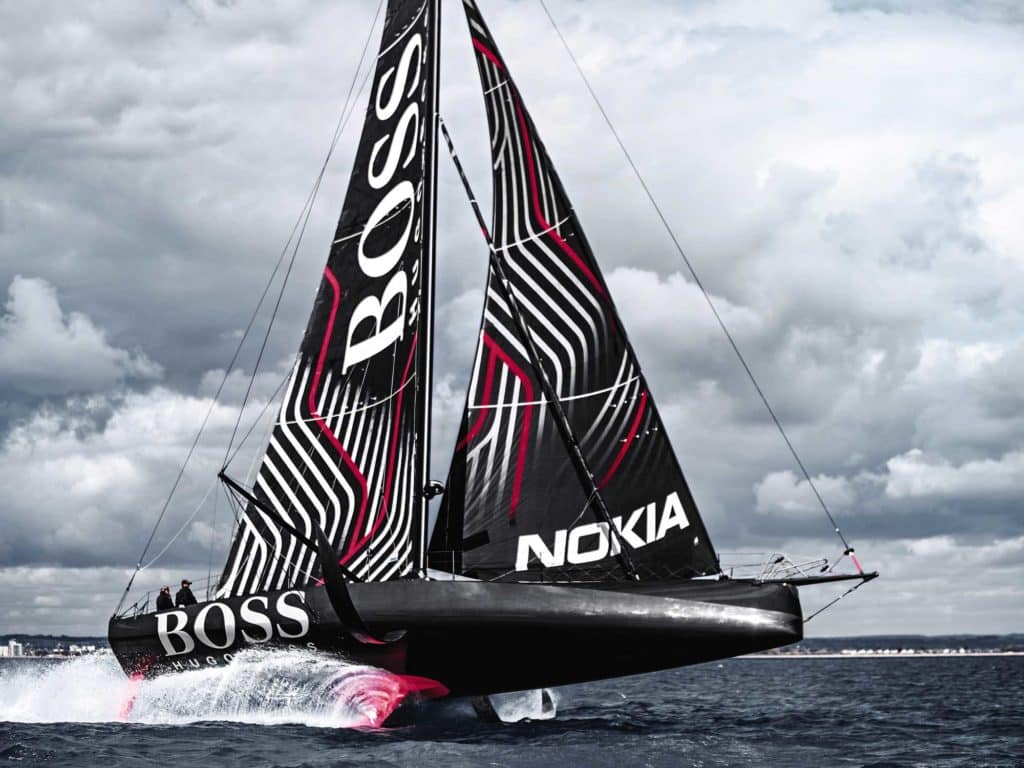
By the 1980s, numerous speed-trial and foil-enhanced offshore-racing multihulls showed huge promise, and have since evolved into behemoth trimarans clocking 30 to 40 knots continuously for long periods, not to mention the monohulls in the Vendée Globe (and soon the Ocean Race) that are capable of speeds exceeding 30 knots. But as boat designer Rodger Martin once reminded me, “If you want a new idea, look in an old book.” He was right. The fully foiling monohulls that will compete in the 2021 America’s Cup will bring things back full circle to the foiling monohull Monitor .
Fluid Dynamics Primer
Any foil—a wing, sail, keel, rudder or lifting foil—redirects the flow of fluid (air included), creating high- and low-pressure areas on opposite sides of the appendage, while developing lift perpendicular to the foil’s surface.
Advancements in foiling science is due in part to the hundreds of foil shapes that were tested, with tabulated results, by the National Advisory Committee for Aeronautics, the forerunner of the National Aeronautics and Space Administration. For the better part of a century now, aircraft and boat designers have been able to choose from a spectrum of refined foil sections that produce predictable amounts of lift and drag for known speeds of fluid and angles of attack, or the angle at which the foil passes through the fluid. Sections of efficient faster foils, as seen on jets or as we flatten our sails to go upwind or reach high speeds, have smaller nose radii and are thinner, with the thickest section of the foils farther aft, up to nearly halfway toward the trailing edge.
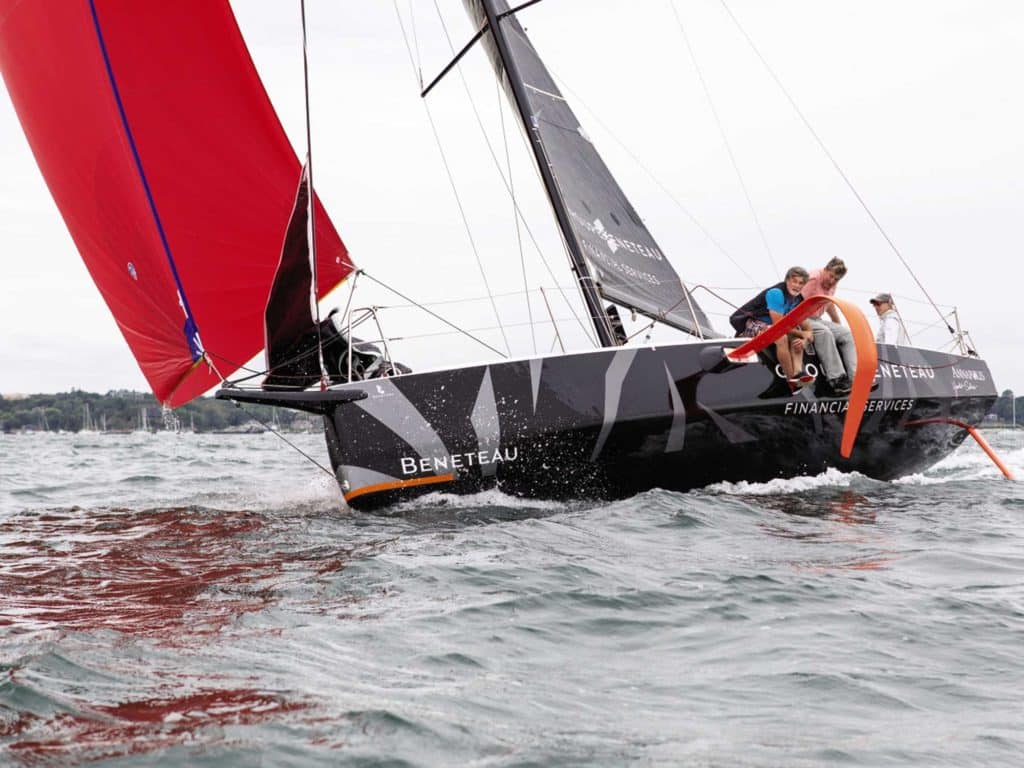
The most efficient foil sections at slow speeds are fatter, with the maximum thickness farther forward, and with larger nose radii, than faster foils. The angle to fluid flow or angle of attack also is greater. We see these slower foils on wings of prop planes and sails when off the wind or in light conditions.
Most sailors are familiar with traditional foils on boats, the teardrop sections of keels that produce lift to weather, reducing leeway, and of rudders, allowing them to steer. Even a flat plate can be a foil, but these tend to be inefficient. Such a shape is prone to fluid separation from the surface, meaning they stall easily, and they maintain poor lift-to-drag ratios. Even keels and rudders are somewhat lift-compromised because they are symmetrical and have to work with fluid coming from either side, whereas lifting foils are more like aircraft wings or propellers, with asymmetrical sections honed for performance in a more stable, fluid flow.
The point is, any foil can be employed at various angles to the surface to prevent leeway, produce increased stability, or help lift the boat out of the water. But those not required to work with fluid flowing from opposite sides can then be honed to maximize lift and minimize drag. Asymmetrical foils were used on boats like Bruce King’s bilgeboarders, including Hawkeye , back in the 1970s. And, designers, including Olin Stephens, had previously employed trim tabs behind keels to improve keel performance.
Sails, which are heeled airfoils, not only drive the boat forward, but they also produce downforce, actually increasing the dynamic displacement of the boat. To counter this and keep the boat sailing more upright, multihull designer Dick Newick first employed slanted asymmetrical hydrofoils in the outer hulls of his small charter trimaran, Lark , in 1962. A portion of the lift developed by the hydrofoil resisted leeway, while a portion worked to actually lift the leeward hull, keeping the boat more upright and reducing dynamic displacement and drag.
Anyone who has ridden on even a foil-stabilized boat will know how riding at least lightly on the waves, and especially above them, beats smashing through them. When boats lift off, everything gets a lot smoother, drag falls away, and the boat accelerates.
Cruising on Foils
But why would a cruiser want to whip over the sea? Wouldn’t this demand an inordinate amount of attention by the crew? Would lifting foils even be applicable to a boat that must have substantial displacement to carry crew and stores? Aren’t cruising-boat hydrofoils an oxymoron?
Maybe, but I believe our boats’ hulls are likely to sprout fins much as fish have as we orient foils to more efficiently resist leeway, add stability, aid steering, reduce drag, increase comfort, allow for shallower draft, and enhance wider variations in hull shapes.
Boats have gotten increasingly wide through the years to advance form stability, improve performance (primarily off the wind), and boost interior volume. But the downside is that fat boats tend to slam more upwind. What if you could reduce dynamic displacement of the boat and lift that hull even partially from the water? The result would be less slamming, especially upwind.
At the same time, what about narrower boats that are known for being more seakindly, especially when closehauled, but lack form stability to carry adequate sail area for powering upwind, and tend to roll badly downwind? Or shallow-draft vessels that are lovely for cruising, but again, tend to suffer from reduced stability? Foils can give that stability back.
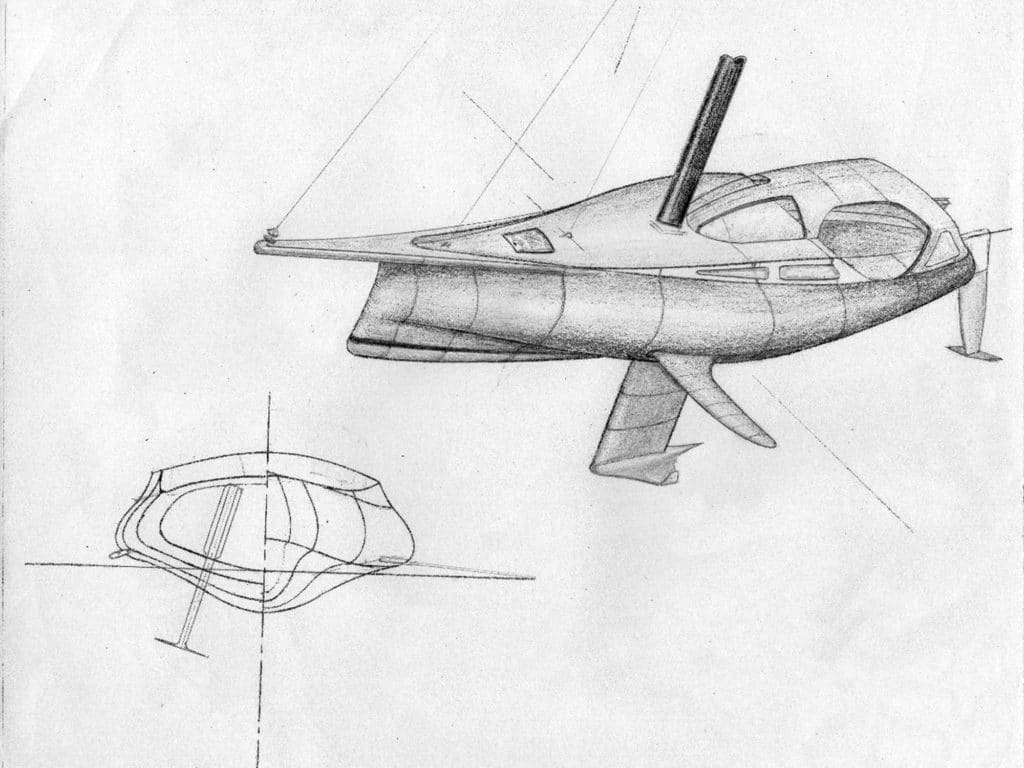
Looking ahead, boat designers might choose to reduce ballast, making up for it with a foil. In short, lifting foils can reduce boat drag and motion while increasing power and performance.
Pitching also does no favors for speed or crew comfort. Foils can come into play here as well. Foils parallel to the sea’s surface resist motion up and down, and a lifted boat skating above chop also is less prone to hobby-horsing through waves. Multihulls have always been particularly susceptible to pitching for a number of reasons, but watching videos of multihulls sailing to weather show an obvious huge advantage that foilers have compared with nonfoilers. Offshore multihulls now routinely employ T-foils on the rudders to control the fore and aft angles of the boat (attitude), a feature easily adaptable to any vessel.
OK, so what’s the cost? Obviously, the more things sticking through the hull, especially if they are retractable, the more it’s going to impact the interior. There would be added weight, complexity and cost. Foils also create noise, and there’s susceptibility to damage from hitting stuff. And let’s not forget compromises with shapes, purposes and things not yet imagined.
As for damage, it’s possible to fold the foils back into the hull. Think swinging center- boards or actual fish fins. Daggerboardlike foils can at least employ shock-absorbing systems similar to the daggerboard arrangements found in many multihulls. This includes weak links that are outside the hull, so if a foil is struck, it frees the foil to fold back or to come off before being destroyed or damaging the hull. Or, foils might hang from the deck rather than penetrating the hull, allowing them to kick up (and to be retrofitted to existing boats). These configurations also relieve the interior of intrusions, and keep the noise more removed from it. I have no doubt that numerous talented designers will be exploring all kinds of options and compromises in coming years, finding ways to make foils both practical and more than worth the compromises.
Sailing more upright, shallower draft, speed, comfort—what’s not to like? Just what is possible? I have a feeling the cruising community is about to find out.
Steven Callahan is a multihull aficionado, boat designer and the author of Adrift , an account of his 76 days spent in a life raft across the Atlantic.
- More: foils , How To , hydrofoils , print june july 2020 , sailboat design
- More How To

Grease the Wheels of Your Boat: A Guide to Proper Lubrication

A Bowsprit Reborn: A DIY Renovation Story

Rigging Redo: Our Switch to Synthetic

Top Tools for Sailboat Cruising: Must-Have Gear for 2024

Galápagos: A Paradise Worth the Paperwork

Around Alone

- Digital Edition
- Customer Service
- Privacy Policy
- Terms of Use
- Email Newsletters
- Cruising World
- Sailing World
- Salt Water Sportsman
- Sport Fishing
- Wakeboarding
- Yachting World
- Digital Edition

World’s fastest monohull: Malizia-Seaexplorer IMOCA 60
- August 17, 2023
The IMOCA 60 Malizia-Seaexplorer is the world’s fastest monohull, having set a blistering 24-hour record of 641.08 nautical miles while competing in The Ocean Race transatlantic leg

Followers of the IMOCA 60 fleet will know that two names have dominated the class over the past two generations when it comes to design: VPLP and Verdier. So, it’s no surprise that all five of the IMOCAs competing in The Ocean Race come from those same drawing boards (and in the case of the oldest boat in the fleet, the 2015-launched Guyot Environnement, a VPLP/Verdier partnership).
Of the four designs, three are by Verdier – 11th Hour Racing Team , Holcim-PRB , and Biotherm. This leaves Boris Herrmann ’s Malizia-Seaexplorer as the sole latest generation VPLP IMOCA in the race, but the differences in its design concept run much deeper. Malizia-Seaexplorer was, uniquely among the fleet, designed from the outset for both the 2023 Ocean Race and the 2024 Vendée Globe . The result is a distinctively different looking IMOCA.
VPLP explains that the design differs markedly from previous iterations of IMOCA, particularly in the shape of the hull. Much of this was the result of lessons learned during the 2020 Vendée Globe . The main aim of the hull studies VPLP undertook was to optimise Malizia-Seaexplorer’s performance in the heavy seas of the Southern Ocean without compromising its ability to perform in the more moderate conditions expected on the Atlantic stages of both The Ocean Race and Vendée Globe.

Damage to the original L-shaped foils proved fortuitous – the replacement C-shaped ones actually performed better. Photo: Ricardo Pinto/Team Malizia
German skipper Herrmann had made three laps of the planet before the Ocean Race start and had specific ideas he wanted to incorporate into the design. Malizia-Seaexplorer has noticeably full bow sections, a higher freeboard and more curved sheerline. Co-skipper Will Harris explained that the boat’s bow shape and volume are two of its key design features.
“The first 3.5m of the bow were cut off, in effect giving us a scow bow,” Harris said while showing me around the boat in the Newport stopover. “It means we’re less likely to catch the bow as we plough into the wave in front of us. And the added volume up front helps lift the boat back out of the water. You look at a boat like Biotherm, it has a bullet nose. Once it digs in a wave it’s hard to get it back out.
Article continues below…

Extraordinary Boats: the new 11th Hour Racing IMOCA 60
For decades the whole point of designing an IMOCA 60 has been to win the Vendée Globe solo round the…

Extraordinary boats: the new radical PRB IMOCA 60
As if the new PRB IMOCA 60 were not eye-catching enough, the story behind it is truly remarkable. The reason…
“We really thought about this design for the Southern Ocean, and it really pays off in the heavy conditions. It might not be so good in other conditions, in lighter winds the extra volume means it’s heavier, but in the rough conditions it pays off for us.”
Among the Verdier designs, overall race leader Holcim-PRB seems the most similar in terms of bow shape, though it lacks the volume of Malizia. Not surprisingly, the two designs were clearly superior in the arduous 12,000-mile Southern Ocean Leg 3 of The Ocean Race. Holcim-PRB and Malizia-Seaexplorer were 1st and 2nd through the mid-leg scoring gate. Approaching the gate at longitude 143 East, Malizia-Seaexplorer overtook 11th Hour Racing Team in strong north-westerly winds of 20-25 knots to earn 2nd place.

Malizia-Seaexplorer’s notably high freeboard translates to greater headroom inside the cockpit. Photo: Antoine Auriol/Team Malizia
11th Hour’s onboard reporter Amory Ross ruefully described Malizia’s superiority in the sea state as they went past: “After working our way through Biotherm it was Malizia’s turn to do the same to us this afternoon. They seem to be able to carry more sail and keep their bow up, presumably with the shape of their hull, and while we struggled in the waves to keep from nose diving, they were able to sail at the same speed but lower.
“We watched as they sailed down to us, around our bow, and then continued on in a more southerly direction.”
Malizia kept that pace up in heavy conditions on the approach to Cape Horn and rounded the iconic landmark ahead of Holcim-PRB.

Racing at full bore in the Southern Ocean during Leg 3 of The Ocean Race. Photo: Antoine Auriol/Team Malizia
Banana boat
Another design feature Harris credited to their success is the boat’s rocker, the curvature of the hull from bow to stern. Harris said that because the rocker rises up in the stern, it also aids the bow in staying out of the water.
“The rocker continues well into the back of the boat, so the whole boat is like a banana,” Harris said. “The idea behind the rocker rising in the stern is to help lift the bow up even more. By having the stern high we can stack more gear, people and equipment in the back of the boat so the bow comes out even more, so it’s less likely to dig into the waves. The tradeoff is it’s less efficient in marginal planing conditions, it’s a little harder to get on a plane just before foiling, but we feel it’s a very small difference.”
The added freeboard also has multiple benefits, including the boat’s ability to self-right. All IMOCAs must be able to self-right after passing 110° of heel angle. “The higher freeboard means more volume at the front. So, when the bow digs in a wave, there’s a lot of buoyancy to help lift it out of the water. Higher freeboard also means more volume for life onboard. And in the IMOCA rules, a high freeboard means more form stability so we can have a lighter ballast bulb for the 110° test,” Harris adds.

The new borrowed c-shape foils were something of a blessing. Photo: Antoine Auriol / Team Malizia
Foil changes
However, it’s Malizia’s foils that have proven to be an unexpected benefit – especially since they’re not the intended foils, but rather a spare set the team had to switch to after Malizia-Seaexplorer’s version one foils were damaged beyond repair before the race start.
The team’s original set suffered damage on the delivery from Guadeloupe at the end of the Route du Rhum to Alicante for the start of The Ocean Race. Harris said that they experienced some rough conditions on the passage and that when the boat nosedived the loads on the foils were counter to the designed loads. There’s a shaft inside the foils around which the carbon fibre is laid, but the carbon wasn’t strong enough to support the huge loads the foils undergo.
An ultrasound check revealed internal damage, and was followed by a frantic search for a replacement set – the team was fortunate to be able to use a set from designer Sam Manuard, similar to those built for Sam Davies’ new Initiatives Coeur.
“To be honest, it’s been a bit of a blessing,” Harris said. The original foils were L-shaped in profile, whereas the replacements are C-shaped. Harris says the biggest benefit is the way the foils regulate the boat’s motion through waves.

There are 54 separate control lines running into the enclosed cockpit. Photo: Antoine Auriol/Team Malizia
“The C-shaped foils are more polyvalent, they’re good in all conditions,” said Harris. “They’re more vertical in profile, which means there’s more righting moment, more of a daggerboard effect. And when the boat starts to lift out of the water the foil comes out in a natural way and helps stabilise the flight of the boat. It doesn’t leap as much. The L-foils are not as good at managing those leaps, you must play more with their extension. With the C-foils, if they’re extended a bit too much in a gust it’s OK. They allow the boat to lift over the wave and not jump so much that it ventilates.”
The C-shape foil versus L-shape played out dramatically on Leg 5 of The Ocean Race, when 11th Hour Racing Team, Holcim-PRB and Malizia-Seaexplorer all took turns blowing through the race and outright monohull 24-hour records (previously standing at 602 and 618 miles respectively, the latter set by the 100ft Comanche back in 2015). During what’s been dubbed the ‘North Atlantic Speed Sailing Seminar’ Malizia-Seaexplorer ended up with the top number, setting a new record of 641.13 miles in 24 hours on 26 May, having maintained a breathtaking average speed of 26.71 knots.

By IMOCA standards, Malizia’s living quarters are comfortable, with curtained bunks. Despite how snugly the crew are wedged in, Rosalind Kuiper was thrown from her bunk and suffered a head injury in Leg 3, due to the foiling IMOCA’s extreme motion in rough seas. Photo: Antoine Auriol/Team Malizia
“We had exceptional conditions with a flat sea, the wind steady from the right direction, the right angle for such a long time,” said Herrmann.
“No sail changes – actually, we took a reef in and out, so we slowed down for these two moments, but apart from that nothing slowed us down for a longer time. Sometimes, the waves got a little bit shorter and we’d slow down to 18 knots and get a bit stuck in the sea. But most of the time the boat would pass the sea perfectly and fly at 27-34 knots, it felt really relaxed.”
Bulletproof IMOCA 60
Regardless of the foil shape, Malizia-Seaexplorer is a beast of a boat. Harris noted that the boat has 30% more structure than the other IMOCAs. The hull is solid carbon fibre, no foam core, up to 16 layers thick in some places. The trend among the IMOCA class is to eliminate the foam cores and use a monolithic construction process that eliminates the possibility of core failure. Given the 30-knot speeds these boats are capable of, their skippers must have confidence that the machine will not break.
“This is a very good boat for the Vendée Globe, it is very good for the overall campaign,” said Herrmann. “I don’t foresee broken stringers or a delamination after a cold front. We have a monolithic very strong hull, a little heavier but when we are up on the foils we perform very much like the pack.
“We are seeing sensational performances downwind and upwind, a few knots quicker than the old boat, the ergonomics are so much better than the old boat. There are so many good things about this boat.”

Extensive solar panels from Solbian on the side decks and coachroof produce 60% of required power, the rest being generated from two hydro-generators. Photo: Antoine Auriol/Team Malizia
Malizia-Seaexplorer specifications
LOA: 18.28m / 59ft 11in LOA inc bowsprit: 20.12m / 65ft 5in Beam: 5.70m / 18ft 3in Draught: 4.50m / 14ft 8in Displacement: N/A Mast height: 27.24m / 88ft 9in Sail area upwind: 270m2 / 2,906ft2 Sail area offwind: 550m2 / 5,920ft2 Design: VPLP Builder: Multiplast
If you enjoyed this….
Yachting World is the world’s leading magazine for bluewater cruisers and offshore sailors. Every month we have inspirational adventures and practical features to help you realise your sailing dreams. Build your knowledge with a subscription delivered to your door. See our latest offers and save at least 30% off the cover price.
- {{>productsMenu}} Products
- {{>trendsMenu}} News & Trends
- Sailing >
- Monohull sailboats >
- Foiling sailboats
Manufacturers
- Black Pepper Yachts (1)
- McConaghy (1)
- Nautor Swan (1)
- Quant Boats (3)
Intended use
- classic (1)
- cruising (1) coastal cruising fast cruising
- cruising-racing (1)
- daysailer (1)
- racing (6) coastal racing ocean racing one-design
Overall length
Displacement, motor power, fuel capacity.
& reach your clients in one place, all year round
{{product.productLabel}} {{product.model}}
{{#each product.specData:i}} {{name}} : {{value}} {{#i!=(product.specData.length-1)}} {{/end}} {{/each}}
{{{product.idpText}}}
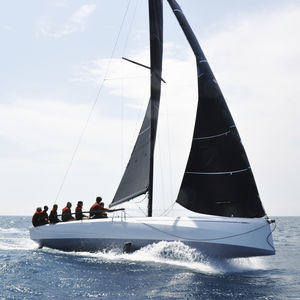
racing sailboat ClubSwan 36
Overall length : 11 m Width : 3.6 m Draft : 2.75 m
The fortune of Nautor’s Swan was born with a 36 footer, one of the first few yachts built in fiber-glass. When the Swan 36 arrived on the scene a new datum was set. With her combination of fast lines, incorporating the modern separated ...

racing sailboat AC40
Overall length : 11.8 m Width : 3.38 m Draft : 3.5 m
Presenting the AC40, a scaled AC75 foiling day-racer designed by Emirates Team New Zealand and built by McConaghy. A one-design class that brings America's Cup foiling performance to a competitive racing circuit. With self-tacking ...
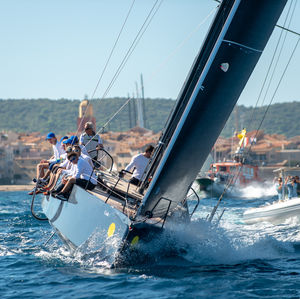
fast cruising sailboat Code 1
Overall length : 12 m Width : 13'00" Draft : 4'01", 9'09"
This magnificent Vintage style, 40-foot yacht, cruising-racing boat built entirely in carbon, with the help of the best French specialists is testament to Black Pepper’s® commitment to “Luxury” and “French Art de vivre”. A purely exceptional ...
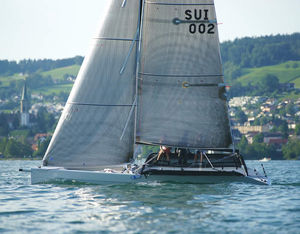
racing sailboat Q30
Overall length : 9.15 m
The new Q30 is closely related to and a further development of the pre-series DSS boat Q28. The Q30 combines unparalleled performance with easier handling on the water, as well as during boat preparation and transportation. The Q30 is ...

racing sailboat Q23
Overall length : 7.01 m
Some dates during summer around the new Q23 if you are maybe interested in having a look at the boat or meet us - this calendar will help. Empty space means that Allianz SUI 002 is somewhere near her home waters Lake of Zurich or Lake ...

racing sailboat Q28
Overall length : 8.53 m
Your suggestions for improvement:
Please specify:
Help us improve:
Receive regular updates on this section.
Please refer to our Privacy Policy for details on how NauticExpo processes your personal data.
- Racing sailboats
- Sailboats with bowsprit
- Carbon mast sailboats
- Carbon sailboats
- Lifting keel sailboats
- Bavaria sailboats
- Bavaria sailboats with bowsprit
- Jeanneau sailboats
- Jeanneau sailboats with bowsprit
- Elan sailboats
- Elan sailboats with bowsprit
- Alubat sailboats
- Pogo Structures sailboats
- Manufacturer account
- Buyer account
- Our services
- Newsletter subscription
- AboutVirtualExpo Group

14 Best Monohull Sailboats

Monohulls are among the most popular boats in the world accounting for over 75% of the total number of boats.
This means that choosing the best monohull sailboats for your sailing adventures can be overwhelming. Fortunately, we're here to help you by highlighting the best monohull sailboats.
Whether you're an accomplished sailor or just starting in the world of sailing, a monohull boat is an ideal option for anyone who wants a true sailing experience.
Unlike other types of sailboats, the level of adrenaline that a monohull brings to your sailing adventure is almost unmatched.
It doesn't matter whether the conditions are rough , wild, flat, or calm, a monohull is the perfect boat type for anyone looking for the thrills of the sail.
Unfortunately, you might not fully enjoy the thrills of sailing on a monohull sailboat if you do not choose the best monohull sailboat for you.
While a monohull cannot compete with multihull sailboats in terms of cabin size, anchoring closer to the shore, and comfort, it should hold its own if you are planning to spend more time at the sea and in unpredictable conditions.
A monohull sailboat will definitely be an ideal option if you're planning to go to more challenging places. This is exactly why you have to make the right choice when looking for the best monohull sailboat.
Over the years, we've sailed many monohull sailboats and that's precisely why we feel confident that we can help you choose the best monohull sailboats.
We've gone through various designs and launches, tested them, and sifted through many monohull brands to select the best monohull sailboats that we strongly believe should be on your bucket list.
So without further ado, let's walk you through them.
Table of contents
Best Monohull Sailboats
{{boat-info="/boats/amel-55"}}
For several decades, Amel 55 has not only been the epitome of easy downwind handling but has developed a cult-like following among sailors. It was designed as the successor to the legendary Super Maramu and brings to the fore incredible features that every serious sailor will value. From a sturdily built hull, solid guardrails to a skeg-hung rudder, watertight bulkheads, and lush bulwarks, Amel 55 is built with anything you could ever want in a perfect monohull sailboat.
And even with a list of standard features, this monohull sailboat is truly designed for those who want to live comfortably on a sailboat for long periods. It comes with superb sea berths with lee cloths, a dishwasher, crockery, an electric furling main and genoa, and several practical items that will make sailing very comfortable.
We have to admit that the design might look old going by modern standards, especially with the advent of easier sail handling systems. For example, the ketch rig design is no longer ideal and is out of fashion. But even with this downside, the Amel 55 remains a phenomenon; a legendary monohull sailboat that ticks all the right boxes in the sailing world.
2. Bavaria Cruise 46
{{boat-info="/boats/bavaria-46-cruiser"}}
Probably the most popular monohull sailboat in recent years, the Bavaria Cruise 46 is a formidable monohull sailboat that was voted "European Yacht of the Year" in 2015. Well, this shouldn't be surprising as you'll probably never find another monohull sailboat in its class that offers more comfort, more space, more luxury, and easier handling.
You can transform the boat's 3 cabins into 4 cabins by transforming the huge forward cabin into two smaller cabins in a few simple steps. In the bow, you'll find a large and luxurious master cabin that can be easily divided using an innovative Flexi-bulkhead.
Its sporty design on the exterior, lightweight composite steering wheels, and a flexible selection of wood tones makes it look so good while offering the best dimensions for both short and long trips. In essence, the Bavaria Cruise 46 is an elegant monohull sailboat that redefines modern sailboats with its clever and innovative design.
3. Hallberg-Rassy 48 Mk II
{{boat-info="/boats/hallberg-rassy-48-mk-ii"}}
Following in the footsteps of the original Hallberg-Rassy 48 Mk that was launched a decade ago, the Mk II was launched in 2014 as an updated version thanks to its modern profile, incredible hull portlights, and larger and frameless windows. This Swedish monohull sailboat is solidly built, gorgeously finished, and is famous around the world and among sailors for its kind and smooth behavior at sea.
Its center cockpit is a true definition of what comfort should entail at sea. This is a monohull sailboat that will provide you with steady sailing both upwind and downwind. It can effortlessly cover 200 miles a day and doesn't require you to be a pro sailor to be able to handle it. If anything, it offers smooth sailing and can be perfectly handled by a casual sailing couple .
In terms of additional features, this monohull comes with a large chart table, lots of stowage and space, a secure linear galley, as well as extra machinery and gear that would be of great help when out on the water. This is a well-thought-out monohull sailboat and is perhaps the best Hallberg-Rassy ever built. This boat guarantees reliability, top-notch quality, and superb resale value.
4. Catalina 545
{{boat-info="/boats/catalina-545"}}
As one of the largest monohull sailboats in the game, the Catalina 545 stands out in the way it's engineered and designed to make it a truly excellent monohull sailboat. If you're an ardent Catalina fan, you'll notice that the 545 has some of the most eyebrow-raising features in bluewater cruising.
For example, the fiberglass collar is designed all-round the top of the hull and shaped like a construction beam. This is to give the hull a more enhanced rigidity while providing a sturdy base for the deck. It's also designed with solid stanchions and cleats, as well as strong sheer rails.
This superb monohull sailboat is constructed with a set of scuppers that play a crucial role in draining near the waterline so that you can perfectly eliminate any development of streaks or strains on the top side of the boat. As far as the bow is concerned, the sprit brings to the table an essential but unique anchor roller, a self-tacking jib, and a light displacement that makes the boat quick even in light or moderate wind. In essence, this monohull sailboat is designed with simple but reliable systems that are easily accessible. Better still, it remains one of the biggest monohull sailboats around.
5. Discovery 55
{{boat-info="/boats/discovery-55"}}
Having been launched two decades ago in 2000, the Discovery 55 has unquestionably stood the test of time and remains one of the most preferred monohull sailboats for families and couples around the world. This is a well-balanced and elegantly designed sailboat that brings to the sailing world immense practicality, comfortable seating, a deep and secure cockpit, dedicated stowage, and a self- tacking jib among many other things.
If you've been on a sailboat and bruised or stubbed your toes, you simply appreciate hos the superb monohull sailboat is designed to keep you safe and secure at all times. From the grab rails and handholds to deep sinks in the galley, the Discovery 55 is designed with plenty of nifty details and the inclusion of many practical ideas.
This sailboat will probably never disappoint you. It is well-mannered, comfortable to live on for days if not months, and a true definition of modern and luxurious.
6. Contest 50CS
{{boat-info="/boats/contest-50cs"}}
If you want a serious monohull boat that can help you extend your sailing ground with ease and perhaps without even realizing it, the Contest 50CS is the way to go. For close to two decades, this Dutch-made monohull sailboat has been a consistent performer even with its dry weight of 17.5 tons.
This monohull is designed with impeccable modern underwater sections and a completely balanced rudder. Although the in-mast furling may affect the boat's performance, this boat can still perform incredibly well without it.
The fact that this boat is designed with a mainsheet traveler and electric winches that can be easily accessed from the helm makes it an ideal boat for a small crew or if you're planning to sail shorthanded. The genoa is easy to tack and two people can easily gybe downwind under spinnaker.
In addition to having exceptional touches on the interior, you might be surprised to learn that the joinery finish of this boat is arguably among the best in the boating industry. This is a monohull sailboat that's easy to handle, well-built, and has weathered the test of time to still mix it nicely with the big boys of recent years. Well, the Contest 50CS might not be among the cheapest monohull sailboats around but its demand is still soaring even today.
7. Bénéteau Oceanis 45
{{boat-info="/boats/beneteau-oceanis-45"}}
Named yacht of the year in 2012, the Bénéteau Oceanis 45 remains one of the most popular monohull sailboats in the world and for a good reason. This is a sailboat that redefines the important themes that made the Oceanis 50 so popular in a much better way.
One of the most noticeable features of this boat is that the mainsheet is designed in such a way that it doesn't obstruct the cockpit as you tack or jibe. This just a start; the cockpit is nicely designed and will serve you just right during your sailing endeavors. This monohull sailboat comes with three or four cabins, two bathrooms, and has a larger cockpit than other boats in its class.
This is a boat that keeps up with the Bénéteau tradition of being ahead of the game in terms of innovation, attention to detail, and offering top-notch performance. Whether you're looking to live aboard or sail to the remotest of places, this gorgeous monohull sailboat has everything you need in place.
8. Jeanneau Sun Odyssey 36i
{{boat-info="/boats/jeanneau-sun-odyssey-36i"}}
Another French monohull sailboat that makes it to this list, the Odyssey 36i is a great monohull sailboat that is acknowledged for having some excellent assets in terms of sailing as it is faster and more agile than most sailboats. This is, without a doubt, an elegant monohull sailboat that brings to the sailing world an overall melodious package in terms of its modern design, power, and capability when sailing.
Even though its hull is of modest size, this monohull sailboat offers great value as it is easy to sail, easy to moor, and dock. Its magnificent electronics, folding prop, and electric anchor winch seem to make everything so easy that you do not even need a crew to sail this boat. The hull is lively and offers good acceleration. Imagine a monohull that can clock around 6.4 knots when sailing upwind.
To be honest, the interior of this boat is still very traditional but the exterior looks quite modern. The exterior is designed like an avant-garde sailboat and looks appealing from just about every angle. In terms of performance, this boat is designed with a deeper keel, spinnaker gear, taller rig, and a much better standing and running rigging.
On the interior, the most noticeable feature is the removable dining table that can be easily removed to accommodate extra bodies. Apart from that, there is nothing complex about the cockpit and deck layout. The double-roller bow fitting is nice and it comes with an optional electric windlass. In essence, this monohull sailboat is designed with lots of features. It is good-looking and reasonably priced.

9. Gunfleet 43
{{boat-info="/boats/gunfleet-marine-gunfleet-43"}}
For many sailors who have the dream of spending most of their time sailing to exotic places, the prospects of downsizing and living most of your essentials at home can be daunting. In other words, it's almost impossible to pack all your life in a 40 feet vessel if you've lived your entire life in a 2,000 feet house. While you can't bring things like your hot bathtub to the ocean, the Gunfleet gives you the chance of bringing most of your essential onboard thanks to its immense spaciousness.
This British-built monohull sailboat is modern, sleek, but kind of feels like a classic sailboat. It comes with an efficient hull that's laid up by hand to enhance attention to detail. The reverse transom brings to the fore a three-step ladder leading to the deck and a small swim platform. It's also designed with a low coach roof and a windshield that seems to taper towards the aft of the cockpit.
Its impeccable low profile gives it a contemporary look but the center-cockpit design is the most attractive part of its design. The aft deck section is expansive and comes with excellent twin zones for sunbathing. They're divided by a skylight and a hatch that lead to the master stateroom that's located below. Its two cabins and two heads are essential if you're planning for long passages. The interior is posh and offers ample natural light.
As far as performance and acceleration are concerned, this monohull sailboat holds well. It accelerates nicely even when out of tacks since the helm is responsive no matter the point of sail. This is an outstanding monohull sailboat that has a solid feel and will most certainly boost your confidence if you're planning to go for long passages even in snobbish conditions.
10. Island Packet 35
{{boat-info="/boats/island-packet-35"}}
Designed to offer top-notch performance, stability, and comfort, the Island Packet 35 is widely known for its spaciousness, modern interior, U-shaped galley, and a vast cockpit that certainly compares to most modern 40 feet sailboats while still holding to the classic lines.
This incredible monohull sailboat is designed with a short spoon, generous spring to the sheer, and a chopped off transom. It is perfectly designed bowsprit elongates the sheerline, which essentially makes the boat appear longer, lower, and much better than it is. As far as the keel is concerned, this is a full keel that's not heavy but very moderate.
The interior of this boat will probably make you think that you're looking at a 40-footer sailboat. It's so spacious that you can use it for your liveaboard sailing escapades. It also offers notable improvements in performance and certainly surpasses some of the company's earlier models. In ideal conditions, very few boats will match the Island Packet 35 in terms of performance. This is a very stable and comfortable monohull sailboat that doesn't hold back as far as performance is concerned.
11. Bowman 40
{{boat-info="/boats/chuck-paine-bowman-40"}}
Thanks to its medium-to-heavy displacement structure, the Bowman 40 is designed to sail across open seas with ease. A modern classic, this monohull sailboat looks pretty much traditional thanks to its overhanging bow, deep-bilged, and narrow shoulders. This makes it very powerful on the waters and offers a lot easier motion during long passages.
Better still, this sailboat is perfectly stable and enjoyable since you won't be thrown about even in strong waves. It's designed with handholds within reach both above and below the deck, as well as no sharp edges to ensure that you don't injure yourself. This is enabled by the balanced hull and carefully integrated sails, as well as ample ballast that's neither heavy nor lightweight. In short, this is a solidly built monohull sailboat that will serve you diligently even when you are confronted with stormy conditions.
Honestly speaking, the Bowman 40 isn't a racing cruiser but neither is it a slouch. It has the ability to sail through the heaviest of oceans and might arrive at your destination just at the same time as other lightweight sailboats. This is, without a doubt, a sailboat that's designed to take you offshore in all weather and sea conditions.
12. Bavaria Cruiser 51
{{boat-info="/boats/bavaria-51-cruiser"}}
Even though it is one of the largest monohull sailboats, you'll probably never notice this once you start sailing. Well, this is because it handles unbelievably so well and can easily and comfortably accommodate up to ten crew members thanks to its three cabins. To offer optimum luxury, this boat can be customized to have five cabins, which is clear evidence that it can meet various needs.
This boat isn't just about being spacious. Instead, it's designed with all functionalities to enable you to enjoy your sailing adventures. Whether you take a look at its exterior, interior, deck, or cockpit, you'll realize that every part of this gorgeous monohull sailboat oozes class. While the most striking of this vessel's interior is its enormous space, it's also designed elegantly and beautiful to ensure that you enjoy your sailing adventures.
In terms of its hull, you're getting a very agile boat that you can easily control even when the winds are extremely strong. In essence, this is a monohull sailboat that's well and generously proportioned in all aspects. It's modern, sleek, and will turn head whether at the dock or deep at sea.
13. Wauquiez Centurion 57
{{boat-info="/boats/wauquiez-centurion-57"}}
Thanks to its exciting Mediterranean-style design and functionality, the Centurion 57 is a serious monohull sailboat that feels robust, solid, and truly marks the reincarnation of the legendary Centurion generation of luxury monohull sailboats. Designed as a racing sailboat, the Centurion 57 is thoroughbred, powerful, and impeccably maneuverable but that doesn't mean that you have to use it as a racing cruiser.
Instead, it's comfortable, luxurious, and elegant and brings to the fore everything that French boat makers are known for: class, beauty, and reliability. Its hull is unquestionably one of the most powerful and versatile. It's designed to withstand the harshest of sailing conditions .
It has a very spacious and large cockpit that's designed to afford you maximum versatility while out there. This means that you'll get lots of free space to efficiently maneuver the boat in the tightest situations and also to make things a lot easier if you're sailing shorthanded. From the electric winches to the helm position, you can easily access the transoms.
This is a monohull sailboat that guarantees calm, luxury, and comfort without compromising on performance and speed. It oozes modernity, solidity, and immense attention to details.
14. Rustler 42
{{boat-info="/boats/rustler-yachts-rustler-42"}}
If you've been looking for a monohull sailboat that combines serious performance attributes to other crucial blue water cruising elements, look no further than the Rustler 42. This is a gorgeous, fast, and reliable monohull sailboat that remains the benchmark of all monohull sailboats of its size. It not only offers directional stability but can also carry immense loads and is solid enough even for long passages.
This is a classing looking monohull sailboat that perfectly combines traditional style with modernity and innovativeness. It is not only elegant but also very stable and should be an ideal choice if you're looking for the best liveaboard monohulls.
Its spacious cabin is big enough to offer standing headroom and, of course, plenty of storage within the lockers. The hull is hand-laid using glass fiber reinforced polyester to ensure that it's solid, reliable, and durable.
In Conclusion
There you have it; the above-described vessels are the best monohull sailboats today. They are designed to enhance your sailing experience and ensure that you always enjoy your time out there on the water. Whichever boat you choose, it's essential to ensure that it's in good condition, well-maintained, and in perfect shape for your adventures.
Until next time, stay safe and happy sailing!
Related Articles

Daniel Wade
I've personally had thousands of questions about sailing and sailboats over the years. As I learn and experience sailing, and the community, I share the answers that work and make sense to me, here on Life of Sailing.
by this author
Best Sailboats
Most Recent

What Does "Sailing By The Lee" Mean?
October 3, 2023

The Best Sailing Schools And Programs: Reviews & Ratings
September 26, 2023
Important Legal Info
Lifeofsailing.com is a participant in the Amazon Services LLC Associates Program, an affiliate advertising program designed to provide a means for sites to earn advertising fees by advertising and linking to Amazon. This site also participates in other affiliate programs and is compensated for referring traffic and business to these companies.
Similar Posts

Affordable Sailboats You Can Build at Home
September 13, 2023

Best Small Sailboats With Standing Headroom
December 28, 2023

Best Bluewater Sailboats Under $50K
Popular posts.

Best Liveaboard Catamaran Sailboats

Can a Novice Sail Around the World?
Elizabeth O'Malley
June 15, 2022

4 Best Electric Outboard Motors

How Long Did It Take The Vikings To Sail To England?

10 Best Sailboat Brands (And Why)
December 20, 2023

7 Best Places To Liveaboard A Sailboat
Get the best sailing content.
Top Rated Posts
© 2024 Life of Sailing Email: [email protected] Address: 11816 Inwood Rd #3024 Dallas, TX 75244 Disclaimer Privacy Policy

Published on June 2nd, 2017 | by Assoc Editor
Foiling and Foil Shapes, a Beginner’s Guide
Published on June 2nd, 2017 by Assoc Editor -->
by Mark Chisnell, Land Rover BAR The rules covering the design and construction of the team’s America’s Cup Class (ACC) boat have defined many of the parts of the boat, including the hull and crossbeams (together called the platform), and the wing shape and size. What’s left for the team’s designers and engineers to work on is principally the daggerboards and rudders, and the control systems that operate them along with the wingsail.
A lot of the technology that goes into the control systems is hidden well inside the hull, with just glimpses of the HMI (human machine interface) that the sailors use to control the board rake, wing trim and so on. The foils are on full view however, so we thought a beginners guide to ACC foil design would come in useful now the racing is approaching.
Basic Principles The foils use exactly the same scientific principles as an aircraft wing. Just as an aircraft wing will lift a plane up off the ground, the foils of an America’s Cup Class boat will lift it out of the water. Wings are foils too, called aerofoils because they work in air. The foils on the new America’s Cup boats are more accurately called hydrofoils, because they work in water.
The secret to both types of foil is the shape – aerofoils and hydrofoils use a special shape to guide the wind or water around them, and generate the lifting force to get planes and boats up in the air. Of course, the America’s Cup boats also use an aerofoil. The main wingsail works exactly the same way as an aircraft wing, it’s just rotated to stand up straight, rather than lie flat.

While an aircraft needs an engine to push the air over the wing fast enough to generate enough force to lift the aircraft up off the ground, the wingsail on the Cup boat generates force from the wind blowing past it. The harder the wind blows, the more force it makes to push the boat forward. When the boat is going fast enough, the hydrofoils will then be able to create enough force to lift the boat out of the water. This reduces resistance to the forward motion and the boat goes faster still.
There are four hydrofoils on the boat — we count the rudders at the back because they have small wings at the tips called elevators. However, the real power to keep the boat in the air comes from the hydrofoils (the daggerboards, as you will often hear them called by the sailors) and we will concentrate on these.
The L-Foil The L-foil is exactly that; a vertical daggerboard shaft that goes through the hull of the boat, with a single horizontal hydrofoil on the bottom, the whole thing shaped like an ‘L’. If nothing else changes, then the L-foil keeps generating lift as the boat goes faster and so the boat keeps rising, and as it rises, less and less of the daggerboard is in the water.
At the basic level, two things then happen: firstly, the boat starts to slip sideways because there is less of the vertical part of the daggerboard in the water and this makes the boat feel unstable and hard to steer. Then, ultimately, if the boat keeps rising the horizontal part of the board that is doing all the lifting will break the surface. If it does, there will be a catastrophic loss of lift and the boat will come crashing back down.
Aircraft use moving parts on the foils to control the amount of lift – trailing edge flaps — but the rules forbid these on the ACC boats, so to maintain stable flight the sailors change the rake or angle of attack of the whole dagger board (and hence the foil) to the water.
Rake If you rake the board backwards as the boat accelerates, the lift will reduce and the boat will come to an equilibrium at a steady height above the water. This is all well and good until the conditions change, maybe the wind speed goes up or down, or the boat hits some waves. When that happens the rake will need further adjustment to find the new equilibrium… until the next puff or lull when it must change again.
In the big breeze and rough water of San Francisco Bay in the 34th America’s Cup it turned out that these moments of equilibrium didn’t last very long and on occasions barely existed at all. The crew’s ability to generate the hydraulic power to change the board and wing trim was simply overwhelmed; they couldn’t achieve stable flight.
V-foil The solution was what’s called the V-foil, in which the horizontal part of the ‘L’ is angled upwards to form more of a ‘V’ shape (the angle at the bottom of the ‘V’ is called the dihedral – a dihedral of 90 degrees would define an L-foil, less than that is progressively more of a V-foil).
The V-foil uses the same principle as one of the most successful original foiling powerboats. The grand old man of 19th century innovation, Alexander Graham Bell put a couple of 350hp engines on the back of what was called HD-4 and set a new marine world speed record in 1919 of just over 70mph.
HD-4 used three ‘ladders’ of small foils, one at the front, and one each side close to the back. When the boat accelerated it started to lift out of the water, and as it lifted, one by one the ‘rungs’ of the foils would break clear of the water. As they did so the lift would decrease, and unless the boat continued to accelerate the boat would stop rising and settle at an equilibrium.
The V-foil achieves this same effect with a single foil and is used in the commercial application of fast ferries— one runs between Southampton and Cowes on the Isle of Wight, right across the Solent waters where the team train, and has done so (on and off) since 1969 – so V-foils are well understood.
When a boat equipped with a V-foil keeps rising as more lift is generated by faster speeds, both parts of the ‘V’ come out of the water together. Critically, when the ‘horizontal’ section starts to break the surface at the tip, it has the effect of reducing the lift gradually, because it doesn’t all come out of the water together. So the boat comes back down gently, working towards an equilibrium ‘ride height’ of its own accord.
It might be that it doesn’t reach this equilibrium before something else changes, but the V-foil has some inherent stability (unlike the L-foil) that doesn’t require human intervention. The shape provides a feedback mechanism to control the amount of lift and produce a more stable ride at a consistent height above the water. The downside of the V-foil is that it will generate less lift and more drag than the L-foil under the same conditions, because some of the lift generated is pushing sideways rather than up.
So one of the big questions facing the teams at the outset of this campaign was whether or not the sailors could achieve stable flight with an L-foil in the new boats and the new venue. Bermuda was a very different place to San Francisco; the winds were expected to be lighter, the water flatter and it seemed that stable flight should be easier to achieve with an L-foil under human control.
A huge amount of work has gone into foil and control system design and we now know that the answer is yes, they can – all the teams are using L-foils, often with unloaded dihedral angles of greater than 90 degrees. These angles close as the boat sails and the foil is loaded up to become much closer to, or 90 degrees.
Cant Another buzz word for the 35th America’s Cup is the cant. The cant of the board is similar to the rake, except that the bottom of the board is moving sideways across the boat, to and from the centreline, rather than backwards and forwards. When the board is canted outwards (towards the edge of the boat) it creates greater ‘righting moment’ and more power to drive the boat forwards.
Righting Moment When the wind hits a sail it creates the force to move the boat forward but it also creates a force that is trying to tip the boat over. If you have ever seen a dinghy or yacht knocked flat by a big gust of wind then you’ve already got the idea.
It’s considerably simplified, but essentially the more force that can be applied to resist the wind’s effort to tip the boat over, then the faster the boat will go, because more of the wind’s energy can be captured and applied to forward motion. The resisting force is called the righting moment and creating as much righting moment as possible is a fundamental principle of designing fast sailboats. It’s the reason that you see people leaning over the windward side when they are racing, putting bodies as far out on the windward side as possible is creating righting moment.
S-Foil Finally, there’s the question of whether the vertical part of the daggerboard should be straight or ‘S’ shaped. The curve of the S-foil could be used — like the cant — to move the bottom of the board outboard and increase the righting moment. So S-foils are more powerful, but they are also more difficult to use. The curves have to raised up and down through the bearings and internal mechanisms in the hull, and that means a lot of work to keep the friction down and the efficiency high.

Tags: AC35 , America's Cup , foiling , Land Rover BAR , Mark Chisnell
Related Posts

Digital umpiring for the America’s Cup →
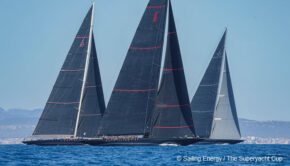
History returns to the America’s Cup →
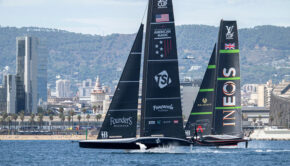
America’s Cup: Improving in real time →
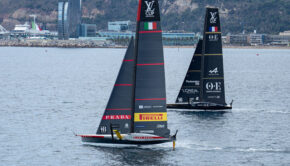
LVC37: Marginal winds challenge teams →
© 2024 Scuttlebutt Sailing News. Inbox Communications, Inc. All Rights Reserved. made by VSSL Agency .
- Privacy Statement
- Advertise With Us
Get Your Sailing News Fix!
Your download by email.
- Your Name...
- Your Email... *
- Email This field is for validation purposes and should be left unchanged.

Yachting World
- Digital Edition

Monofoil: The pocket rocket that can foil in just 8 knots of breeze
- Matthew Sheahan
- October 1, 2019
Built and developed in secret, the 8m Monofoil is a super-fast one-off foiling monohull, originally designed as a lake racer
The spectacle of a flying catamaran, be it an Olympic Nacra 17, a GC32, the recent America’s Cup 50-footers, or anything in between, has become almost normal in today’s racing world, so rapid has the shift to foiling been among multihulls.
But, even 17 years after they first appeared, the sight of a diminutive foiling Moth still turns heads. Foilers don’t have to be big to be impressive, balancing a single hull on a single foil is enough. Like those who can ride a unicycle, there’s something awe-inspiring about watching sailors who have pitch perfect balance fly a twitchy monohull while making it look like the most natural thing in the world.
There have been plenty of attempts to bring monohull foiling to bigger boats and to the masses. Yet no one has yet cracked the code, at least not for production boats.

Little surprise then, that whenever a new monohull foiler comes onto the scene it attracts plenty of attention. One of the latest is the 8m Swiss-built Monofoil. This extraordinary and complex looking boat is essentially a sportsboat with an open cockpit but with outrigger foils, like bicycle stabilisers, that generate righting moment by pushing upwards on the leeward side.
She was designed by Swiss match racing sailor Eric Monnin and built by Damian Weiss, both of whom shared a common goal: to create a fast foiling monohull for the European lakes.
Interestingly, neither had any desire to create a production version, nor tell the world that this was the answer for others. Instead, they simply wanted to find out if they could fly fast enough on one hull to stand a chance of winning some of the big prizes at Europe’s top lake races, including the famous Bol D’Or Mirabaud.
Article continues below…

Charal: On board the radical IMOCA 60 that takes foiling to the next level
In St Malo for the start of the Route du Rhum in early November, every inch of the IMOCA 60…

Eagle Class 53: The foiling cruiser inspired by the America’s Cup
Not everything that flies is destined to scorch around an America’s Cup course. The future for sailing hydrofoils is surely…
Launched in the spring of 2018 after two years of secret development, the initial signs looked good as the 8m sportsboat delivered an impressive opening performance, topping 25 knots on one of her first outings.
After a winter of tweaking and refining, where the team had increased the foils by 20% and reduced her overall weight by 50kg, the Monofoil was back afloat for this season. Shortly after her re-launch at Easter, it was clear that the team had raised the game.
“We can now foil upwind in just 8 knots of breeze,” said Monnin. “And when the breeze builds to 12 knots we are travelling at 16-20 knots at a true wind angle of around 50-60°. When it comes to downwind performance we can happily sit at 22 knots in 12 knots of wind with the gennaker. After that, when the breeze is up to 15-20 we are holding 24-27 knots with just the main and jib,” he continued.

The carbon bowsprit is 1.2m long and cants so the tack of the gennaker can be set further to windward, allowing the Monofoil to sail deeper
All impressive stuff for an 8m monohull. This is a proper pocket rocket that weighs just 650kg and can be rigged off the road trailer and launched in a couple of hours. Indeed, Monnin explains, her performance was in part limited by the need to keep the maximum beam down to 2.5m to meet European towing regulations.
Single hull foiling
So how does the Monofoil work? Setting the foils to one side to start with, the 8m long sportsboat flies a self-tacking jib upwind and a gennaker off a canting bowsprit downwind. She is designed to be raced by a full crew of four, including the helmsman, with two on trapezes to boost the righting moment.
She has a large square-topped mainsail that makes full use of the available space in a sail plan that sees the boom extend all the way to the transom where a full width traveller allows plenty of mainsheet tension to keep the head of the main stand up. This does mean she has a pair of running backstays rather than a single fixed stay, but double aft swept spreaders provide sufficient fore and aft support for the mast.

The foil deployed, but in the raised position. Normally it wouldn’t be underwater but the boat was heeled at the dock
Being a potent performer, she sails at high apparent wind speeds with the apparent wind ahead of the beam. This makes the full width mainsheet traveller an important feature to allow the mainsail to be dropped down to leeward while still maintaining leech tension, much like a multihull.
Her rudder is mounted on a transom-hung gantry to ensure greater efficiency for the T-foil blade. The rake of the rudder can be adjusted to alter the fore and aft trim of the boat.
While the foils look large and complex, their operation is surprisingly simple and belie the amount of work that has gone into designing a complete system that allows the curved foils to slide through a set of bearings in the hull.

A simple rope-driven worm drive alters the rake of the T-foil rudder, which in turn alters the trim of the boat. The rudder is mounted on a gantry off the transom to minimise cavitation
Much like the Beneteau Figaro 3, the idea is that both boards are lowered when sailing. Yet unlike the Figaro, the windward board is lifted partially to help raise it above the water’s surface and reduce the chances of it becoming immersed where it would create drag.
The clever part is the small amount of movement that is required to lift and lower the boards, especially when compared to the amount of movement required to raise and lower daggerboards on a modern multihull.
Also unlike the Figaro, the Monofoil’s boards are fully retracted in light winds. With very little of the foil in the water there is minimal drag and the boat can be sailed like any other monohull.

A custom bearing lets the daggerboard slide vertically to be raised or lowered. Rake is adjusted by the green line winding a worm drive
In these conditions the skinny and efficient 2.2m deep keel, with its 160kg bulb, is a good combination when the breeze is below 8 knots and allows the Monofoil to perform like any other similarly sized sportsboat.
The dihedral (upwards angle) of the foils is also an interesting feature that provides a degree of automatic heel control. As the boat accelerates and comes upright, so less of the foil is in the water, which reduces vertical lift.
Deceptively simple
At rest this boat does look pretty complex, yet once she’s rigged and underway you realise how simple she is to operate as well as how much effort has gone into designing her that way.

Below decks the full carbon construction is clear to see
This is an ingenious trailer-sailer that will fly in light conditions and be stable on foils right up through the wind range, something the crew demonstrated during this year’s Mirabaud Bol d’Or. As a vicious 50-plus knot storm swept through the fleet, she and her crew were one of the few to survive unscathed and go on to complete the overnight race.
The irony remains that – unlike many others in the Bol d’Or – this is not a boat that was intended to be the prototype for a new range of production foilers, even though she appears to provide answers to plenty of questions.
The bottom line is that the Monofoil seems to work. Irrespective of what speeds she clocks up, what is most impressive is how she performs across such a wide range of wind speeds.

Rectangular cut-outs in the hull allow the foil to be lowered completely on the leeward side. The windward foil is raised slightly in a similar way to pulling up a normal daggerboard
The Monofoil is no one-trick pony and while the concept wasn’t created for production, it could provide an appealing route for those who are realistic about their ability to learn how to balance like a Moth sailor, or ride a unicycle.
Specification
LOA: 8.0m (26ft 3in) Beam: 2.5m (8ft 2in) Displacement (empty): 850kg (1,874lb) Mast height: 12.2m (40ft 0in) Mainsail area: 32m 2 (345ft 2 ) Headsail area: 16m 2 (172ft 2 ) Gennaker area: 50m 2 (538ft 2 )

- AMERICA'S CUP
- CLASSIFIEDS
- NEWSLETTERS
- SUBMIT NEWS
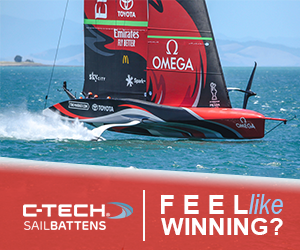
MW40OF - New Foiling Offshore Sailboat Concept
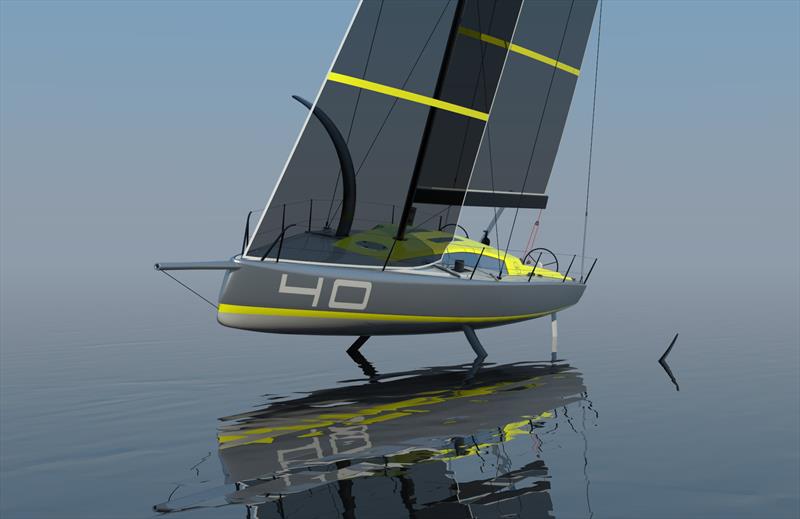
Related Articles
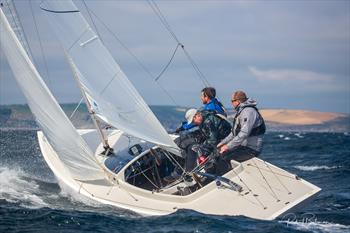
Log in or Sign up
You are using an out of date browser. It may not display this or other websites correctly. You should upgrade or use an alternative browser .
Foil Assist Monohulls
Discussion in ' Sailboats ' started by Doug Lord , Jun 14, 2018 .
Doug Lord Flight Ready
These boats were just published in todays Scuttlebutt Europe: 1- Club Swan 36-retractable foil each side deployed with block and tackle. Foil generates lateral resistance mostly. ------- 2- MCP 24 from Brazil. Proprietary "Sailing Booster" system(DSS!!) featuring two electronic controlled foils allowing reduction in keel weight.
Dolfiman Senior Member
Doug Lord said: ↑ These boats were just published in todays Scuttlebutt Europe: 1- Club Swan 36-retractable foil each side deployed with block and tackle. Foil generates lateral resistance mostly. View attachment 140842 Click to expand...
Wow-a single curved foil! I had an idea for a continuous curved foil for a dinghy a few years ago-never did anything with it. Juan K has what looks like a real good set-up.....
OzFred Senior Member
Doug Lord said: ↑ 2- MCP 24 from Brazil. Proprietary "Sailing Booster" system(DSS!!)… Click to expand...
It's an attempted DSS ripoff ,in my opinion. I sincerely hope they don't get away with it! I sent that original video to Hugh when it first came out so he's already dealing with it.
CT249 Senior Member
There's an interesting recent comment on SA. The guy who now owns the DSS prototype took the foil off it because it didn't work all-round.
CT249 said: ↑ There's an interesting recent comment on SA. The guy who now owns the DSS prototype took the foil off it because it didn't work all-round. Click to expand...
"Spurious claim"? What on earth? How in the world do you know it's a "spurious claim"? You've never seen the boat, you've never sailed the boat, you have probably never seen any unbiased reports. This forum is supposed to be about discussion and learning, which means objective analysis of information such as the account by the owner of a DSS boat, and not your one-eyed abuse of anything that does not match your bias. Oh, and Hugh saw the post and didn't foully insult the boat's owner by claiming he was lying, as you do.
It's a spurious claim because of the implication that DSS does not work. DSS is an overwhelmingly proven technology and for somebody with a "prototype" to claim it doesn't work "all-round" is suspect to say the least. It may be a particular problem with the so-called "prototype" since DSS was tried on conversions where the conclusion was reached that to work at its best DSS needs to be used on a boat designed from scratch for it. Hugh Welbourns comments on this particular boat would be important and reflect the facts(see below). ------------------- Repeating a claim made by someone on another forum with no other supporting facts (when they were available to you*) puts the totally unsupported claim in the category of "spurious". * Such as Hugh Welbourns comments that you could have quoted to provide a more balanced post-you mentioned above that he had responded.
Doug, your post is illogical and insulting. No one posted anything "spurious" which is defined as "false or fake". I wrote what the owner on SA wrote. There are NO supporting facts available to me I left out - in fact I specifically referred to the fact that it was the prototype. Your ducking and weaving cannot obscure the fact that you claimed that the owner of the prototype was making a "false or fake" claim, when you had no evidence for that. That's dishonest. To reject evidence that DSS in one boat did not work as well as claimed undermines your claim that the technology is "overwhelmingly proven". The only honest way to assess whether a technology is "overwhelmingly proven" is by an unbiased and objective assessment of it, and when you launch into attacks like and discard evidence when it doesn't suit you it just makes it even more apparent that you lack the ability to make unbiased and objective assessments.
Doug Lord said: ↑ It's an attempted DSS ripoff ,in my opinion. I sincerely hope they don't get away with it! I sent that original video to Hugh when it first came out so he's already dealing with it. Click to expand...
CT249 said: ↑ … that you claimed that the owner of the prototype was making a "false or fake" claim, when you had no evidence for that. Click to expand...
OzFred said: ↑ You are entitled to your opinion, but to me it’s no more a “DSS ripoff” than DSS is a rip-off of similar systems that can before it (i.e. it isn’t). DSS (that is, the patented Dynamic Stability System) is not just a horizontal stabilising foil, it’s an entire system encompassing the boat and rig design as well as the foil. Since a Sailing Booster System patent has been applied for and the DSS designer is aware of it, perhaps you can let others who know what they are talking about sort out whether it infringes on the DSS patent or not. Click to expand...
Doug Lord said: ↑ It's an attempted ripoff… Click to expand...
- Advertisement:
This is the Abstract of Welbourns patent . Listen to the Sailing Booster video as they try to claim the same benefits for their ripoff foil. A monohull sailing vessel ( 102, 202, 402 , and/or 502 ) having a lifting hydrofoil ( 104 and/or 204 ) having a stowed position and a deployed position in which the hydrofoil extends outward of a leeward side of the hull ( 138 ). The hydrofoil may have an aspect ratio greater than 2.5:1, may be oriented at an angle of attack between 2 and 6 degrees, and may be oriented at a mean angle ( 124 ) of between 5 and 20 degrees to horizontal. The hydrofoil may have a projected area adapted to provide a righting moment and a lifting force for partially but not fully lifting the vessel out of the water. The hydrofoil may have an exposed span ( 112 ) that is greater than about 7% of a height of the tallest mast ( 134 ). The vessel may include an actuation assembly ( 128, 228, 308, and/or 316 ) for moving the hydrofoil between the stowed and deployed positions.
Foils and Foil-assist for Sailing Super Yachts
Foil assist 40fter, imoca 60 2016-2017 foil assist, 2015 imoca 60-foil assist.
Foil Assist for Windsurfer
Foil-Assist Keelboats
Foil assist for keelboats(not dss)-kuka light and others, design for dss-foil assist for keelboats, quant 28-foil assist keelboat / dss.
Catalina Capri 22 fix keel & rudder foil shapes
- No, create an account now.
- Yes, my password is:
- Forgot your password?


IMAGES
VIDEO
COMMENTS
Monofoil: The pocket rocket that can foil in just 8 knots of breeze. Built and developed in secret, the 8m Monofoil is a super-fast one-off foiling monohull, originally designed as a lake racer ...
The faster the boat goes, the more lift the DSS foil provides. A diminutive Quant 23 scow takes to the air during sea trials. Photo courtesy of Quantboats ... monohull—the foiling Moth and the Glide Free kit for Lasers predate it—but it is the first ballast keel-equipped monohull to foil. For this boat, Welbourn added winglets to the rudder ...
Mar 4, 2024. Original: Apr 13, 2017. Although still in development, the Beneteau Figaro 3 represents the cutting edge of production foiing monohull design. Image Courtesy of Beneteau. Examining Vendée Globe boats on the dock in Les Sables d'Olonne prior to the start of the race last November, one thing was perfectly clear: the genie is out ...
The Figaro BENETEAU 3 is the first production foiling one-design monohull ever created.It is a distillation of technology and innovation, the result of a collaboration between some of BENETEAU's best experts and the Van Peteghem Lauriot-Prévost (VPLP) office, the architects of the last two boats to win the Vendée Globe.. The prototype has been tested and the production of the boat has been ...
The Eagle Class 53's roots lie firmly with the foiling America's Cup catamarans. Even in displacement mode she's an exhilarating ride. The goal is to achieve fully foiling performance. It is ...
Jul 22, 2024. Original: Nov 30, 2018. With the TF10, big-boat multihull foiling is now available to amateurs as well as pros. Any time I put a helmet on I become hyper-aware of every step I take. Precaution means there's an alternative to a happy ending. On one of my last rides of the 2018 summer season, the helmet was mandatory, as was the ...
Patriot in flight, but out of control and starting to capsize, 16 Jan 2021. Source: America's Cup video screenshot. The AC75 operates with two completely different sets of boat dynamics: Waterborne while accelerating at maximum power to quickly reach foiling speed at 12 - 14 knots. Flying on the foils to reach a top speed that can exceed 50 ...
The Gonet Monofoil is a revolutionary monohull that lifts out of the water on hydrofoils, the latest in sailings surge into foiling technology.
With the monohull world increasingly embracing foils it seems timely to reflect on some of the lessons learnt over the past year and how 2017 and beyond look for the impact of DSS and for the ...
10. New Zealand 'R' Class skiff. In New Zealand they love their skiff sailing, and development classes like the doublehanded 'R' Class are prime for new features. The 'R' Class started its project to get the fleet foiling back in 2008 and now there are a clutch of boats racing.
Now he continues developing and building foilers, this time a monohull be built with his brother. Foil setup is the usual 3 pt conf with two outward Js and a single T rudder. Looks good a bit sit back as many of these monohulls, except the 69F that always seems to be well balanced. New project for Raphael, and we hope he will pursue more of ...
In 1906, his 1-ton 60 hp foiler reached 42.5 mph. Alexander Graham Bell's HD-4 Hydrodrome flew on Bras d' Or Lake at 70 mph in 1919. And several sailing foiler patents began appearing in the 1950s. Notably, JG Baker's 26-foot monohull, Monitor, flew at 30-plus mph in 1955. Baker experimented with a number of foil configurations, and at ...
But most of the time the boat would pass the sea perfectly and fly at 27-34 knots, it felt really relaxed." Bulletproof IMOCA 60. Regardless of the foil shape, Malizia-Seaexplorer is a beast of ...
CNN —. It's been developed in secret in Switzerland, but a new "flying" yacht could be a taste of things to come for the America's Cup. The Gonet Monofoil is a revolutionary monohull ...
Hydrofoiling wingsail catamaran 17. A sailing hydrofoil, hydrofoil sailboat, or hydrosail is a sailboat with wing-like foils mounted under the hull.As the craft increases its speed the hydrofoils lift the hull up and out of the water, greatly reducing wetted area, resulting in decreased drag and increased speed. A sailing hydrofoil can achieve speeds exceeding double and in some cases triple ...
The foil arms and foil control systems, and the D-section masts are supplied as one-design components. Every team designs its double-skinned mainsail and sailing systems, rudder wings and foil arm wings. Unlike nearly every monohull on the planet, the AC75 does not have a keel, centerboard or even a canard.
Monohull sailboats > Foiling sailboats. Foiling sailboats. 4 companies | 6 products. Manufacturers. B; Black Pepper Yachts (1) M; McConaghy (1) N; Nautor Swan (1 ... Some dates during summer around the new Q23 if you are maybe interested in having a look at the boat or meet us - this calendar will help. Empty space means that Allianz SUI 002 is ...
Better still, it remains one of the biggest monohull sailboats around. 5. Discovery 55. berthoninternational. Having been launched two decades ago in 2000, the Discovery 55 has unquestionably stood the test of time and remains one of the most preferred monohull sailboats for families and couples around the world.
The L-foil is exactly that; a vertical daggerboard shaft that goes through the hull of the boat, with a single horizontal hydrofoil on the bottom, the whole thing shaped like an 'L'.
Built and developed in secret, the 8m Monofoil is a super-fast one-off foiling monohull, originally designed as a lake racer. ... Skip Novak's storm sailing techniques; Sail faster sail safer; Special reports; Watersports. Paddleboarding; About us; Latest issue; Comment; America's Cup;
Built for long distance maxi style Med races, meet the first foiling maxi Flying Nikka. Toby Hodges had an exclusive first sail, with the full story in Yacht...
MW40OF - New Foiling Offshore Sailboat Concept. From the designers of the Persico 69F, the MW40OF is an offshore racer with full foiling capabilities packed into a manageable size and capable of normal docking without issues from foils sticking out and with safety and simplicity as driving factors. Thought for a crew of 5, the concept is 40ft ...
Listen to the Sailing Booster video as they try to claim the same benefits for their ripoff foil. A monohull sailing vessel (102, 202, 402, and/or 502) having a lifting hydrofoil (104 and/or 204) having a stowed position and a deployed position in which the hydrofoil extends outward of a leeward side of the hull (138).